Class 10 Science Chapter 13 Magnetic Effects of Electric Current NCERT Solutions
Before getting into the details of NCERT Solutions For Class 10 Science Chapter 13 Magnetic Effects Of Electric Current, let’s have an overview of topics and subtopics under magnetic effect of electric current class 10 NCERT pdf:
- Magnetic Effects Of Electric Current
- Magnetic Field And Field Lines
- Magnetic Field Due To A Current-Carrying Conductor
- Force On A Current-Carrying Conductor In A Magnetic Field
- Electric Motor
- Electromagnetic Induction
- Electric Generator
- Domestic Electric Circuits
Free download NCERT Solutions for Class 10 Science Chapter 13 Magnetic Effects Of Electric Current PDF in Hindi Medium as well as in English Medium for CBSE, Uttarakhand, Bihar, MP Board, Gujarat Board, and UP Board students, who are using NCERT Books based on updated CBSE Syllabus for the session 2019-20.
- विद्युत धारा का चुम्बकीय प्रभाव कक्षा 10 विज्ञान हिंदी में
- Class 10 Magnetic Effects of Electric Current Important Questions
- Magnetic Effects of Electric Current Class 10 Notes
- Magnetic Effects of Electric Current NCERT Exemplar Solutions
- Magnetic Effects of Electric Current Class 10 Extra Questions
- Class 10 Science Magnetic Effects of Electric Current Mind Map
NCERT Solutions for Class 10 Science Chapter 13 Intext Questions
Page Number: 224
Question 1
Why does a compass needle get deflected when brought near a bar magnet ?
Answer:
The magnetic field of the magnet exerts force on both the poles of the compass needle. The forces experienced by the two poles are equal and opposite. These two forces form a couple which deflects the compass needle.
Page Number: 228
Question 1
Draw magnetic field lines around a bar magnet.
Answer: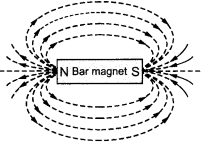
Question 2
List the properties of magnetic lines of force.
Answer:
Properties of magnetic lines of force :
- The magnetic field lines originate from the north pole of a magnet and end at its south pole.
- The magnetic field lines become closer to each other near the poles of a magnet but they are widely separated at other places.
- Two magnetic field lines do not intersect one another.
Question 3
Why don’t two magnetic lines of force intersect each other ?
Answer:
This is due to the fact that the resultant force on a north pole at any point can be only in one direction. But if the two magnetic field lines intersect one another, then the resultant force on north pole placed at the point of intersection will be along two directions, which is not possible.
Page Number: 229 – 230
Question 1
Consider a circular loop of wire lying on the plane of the table. Let the current pass through the loop clockwise. Apply the right hand rule to find out the direction of the magnetic field inside and outside the loop.
Answer:
As shown in figure alongside, each section of wire produces its concentric set of lines of force. By applying right hand thumb rule, we find that all the sections produce magnetic field downwards at all points inside the loop while at the outside points, the field is directed upwards. Therefore, the magnetic field acts normally into the plane of the paper at the points inside the loop and normally out of the plane of paper at points outside the loop.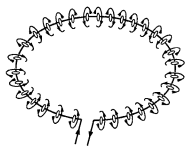
Question 2
The magnetic field in a given region is uniform. Draw a diagram to represent it. [CBSE 2013, 2014]
Answer:
A uniform magnetic field in a region is represented by drawing parallel straight lines, ail pointing in the same direction.
For example, the uniform magnetic field which exists inside a current-carrying solenoid can be represented by parallel straight lines pointing from its S-pole to N-pole (as shown in figure).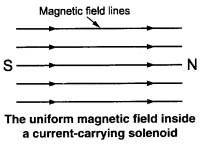
Question 3
Choose the correct option.
The magnetic field inside a long straight solenoid-carrying current
(i) is zero
(ii) decreases as we move towards its end
(iii) increases as we move towards its end
(iv) is the same at all points
Answer:
(iv) Is the same at all points.
Page Number: 231 – 232
Question 1
Which of the following property of a proton can change while it moves freely in a magnetic field. (There may be more than one correct answer.)
(i) Mass
(ii) Speed
(iii) Velocity
(iv) Momentum
Answer:
The correct options are (iii) velocity, (iv) momentum.
Question 2
In Activity 13.7 how do we think the displacement of rod AB will be affected if (i) current in rod AB is increased (ii) a stronger horse-shoe magnet is used; and (iii) length of the rod AB is increased ?
Answer:
(i) When the current in the rod AB is increased, force exerted on the conductor increases, so the displacement of the rod increases.
(ii) When a stronger horse-shoe magnet is used, the magnitude of the magnetic field increases. This increases the force exerted on the rod and the displacement of the rod.
(iii) When the length of the rod AB is increased, force exerted on the conductor increases, so the displacement of the rod increases.
Question 3
A positively-charged particle (alpha particle) projected towards west is deflected towards north by a magnetic field.
The direction of magnetic field is :
(i) towards south
(ii) towards east
(iii) downward
(iv) upward
Answer:
(iv) Upward.
Here, the positively charged alpha particles are moving towards west, so the direction of current is towards east. The deflection is towards north, so the force is towards north, so, we are given that
(i) direction of current is towards west
(ii) direction of force is towards north.
Let us now hold the forefinger, middle finger and thumb of our left-hand at right angles to one another. Adjust the hand in such a way that our mid finger points towards west (in the direction of current) and thumb points towards north (in the direction of force). Now, if we look at our forefinger, it will be pointing upward. Because the direction of forefinger gives the direction of magnetic field, therefore, the magnetic field is in the upward direction.
Page Number: 233
Question 1
State Fleming’s left hand rule. [CBSE 2018]
Answer:
Fleming’s left hand rule : Stretch the first finger, the middle finger and the thumb of your left hand mutually perpendicular to each other in such a way that the first finger represents the direction of the magnetic field, the middle finger represents the direction of the current in the conductor, then the thumb will represent the direction of motion of the conductor.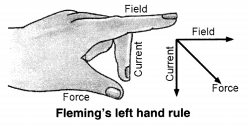
Question 2
What is the principle of an electric motor ? [CBSE 2018]
Answer:
A motor works on the principle of magnetic effect of current. When a rectangular coil is placed in a magnetic field and current is passed through it, a force acts on the coil which rotates it continuously.
When the coil rotates, the shaft attached to it also rotates. In this way the electrical energy supplied to the motor is converted into the mechanical energy of rotation.
Question 3
What is the role of the split ring in an electric motor ?
Answer:
The split ring reverses the direction of current in the armature coil after every half rotation, i.e., it acts as a commutator. The reversed current reverses the direction of the forces acting on the two arms of the armature after every half rotation. This allows the armature coil to rotate continuously in the same direction.
Page Number: 236
Question 1
Explain different ways to induce current in a coil.
Answer:
Different ways to induce current in a coil are :
- moving a magnet towards or away from the coil or vice-versa, and
- changing current in the neighbouring coil.
Page Number: 237
Question 1
State the principle of an electric generator.
Answer:
The electric generator works on the principle that when a straight conductor is moved in a magnetic field, then current is induced in the conductor.
In an electric generator, a rectangular coil is made to rotate rapidly in the magnetic field between the poles of a horse-shoe type magnet. When the coil rotates, it cuts the magnetic field lines due to which a current is produced in the coil.
Question 2
Name some sources of direct current.
Answer:
Some of the sources of direct current are dry cells, button cells, lead accumulators.
Question 3
Which sources produce alternating current ?
Answer:
Alternating current is produced by AC generators of nuclear power plants, thermal power plants, hydroelectric power stations, etc.
Question 4
Choose the correct option : A rectangular coil of copper wires is rotated in a magnetic field. The direction of the induced current changes once in each:
(i) two revolution
(ii) one revolution
(iii) half revolution
(iv) one-fourth revolution
Answer:
(iii) Half revolution.
Page Number: 238
Question 1
Name two safety measures commonly used in electric circuits and appliances.
Answer:
(i) Earthing and
(ii) Electric fuse.
Question 2
An electric oven of 2 kW power rating is operated in a domestic electric circuit (220 V) that has a current rating of 5 A. What result do you expect ? Explain.
Answer:
The electric oven draws a current given by![]()
Thus the electric oven draws current much more than the current rating 5 A. That is the circuit is overloaded. Due to excessive current, the fuse wire will blow and the circuit will break.
What precautions should be taken to avoid the overloading of domestic electric circuits ?
To avoid the overloading of domestic electric circuits, the following precautions should be taken :
(i) The wires used in the circuit must be coated with good insulating materials like PVC, etc.
(ii) The circuit must be divided into different sections and a safety fuse must be used in each section.
(iii) High power appliances like air-conditioner, refrigerator, a water heater, etc. should not be used simultaneously.
NCERT Solutions for Class 10 Science Chapter 13 Textbook Chapter End Questions
Question 1
Which of the following correctly describes the magnetic field near a long straight wire ?
(i) the field consists of straight lines perpendicular to the wire
(ii) the field consists of straight lines parallel to the wire
(iii) the field consists of radial lines originating from the wire
(iv) the field consists of concentric circles centred on the wire
Answer:
(iv) The field consists of concentric circles centred on the wire
Question 2
The phenomenon of electromagnetic induction is
(i) the process of charging a body
(ii) the process of generating magnetic field due to a current passing through a coil
(iii) producing induced current in a coil due to relative motion between a magnet and the coil
(iv) the process of rotating a coil of an electric motor
Answer:
(iii) Producing induced current in a coil due to relative motion between a magnet and the coil
Question 3
The device used for producing electric current is called a
(i) generator
(ii) galvanometer
(iii) ammeter
(iv) motor
Answer:
(i) Generator.
Question 4
The essential difference between an AC generator and a DC generator is that
(i) AC generator has an electromagnet while a DC generator has permanent magnet
(ii) DC generator will generate a higher voltage
(iii) AC generator will generate a higher voltage
(iv) AC generator has slip rings while the DC generator has a commutator
Answer:
(iv) AC generator has slip rings while the DC generator has a commutator
Question 5
At the time of short circuit, the current in the circuit
(i) reduces substantially
(ii) does not change
(iii) increases heavily
(iv) varies continuously
Answer:
(iii) Increases heavily.
Question 6
State whether the following statements are True or False.
(i) An electric motor converts mechanical energy into electrical energy.
(ii) An electric generator works on the principle of electromagnetic induction.
(iii) The field at the centre a long circular coil carrying current will be parallel straight lines.
(iv) A wire with a green insulation is usually the live wire of an electric supply.
Answer:
(i) False
(ii) True
(iii) True
(iv) False.
Question 7
List three sources of magnetic fields.
Answer:
(i) Current carrying conductor
(ii) Electromagnets
(iii) Permanent magnets
Question 8
How docs a solenoid behave like a magnet ? Can you determine the north and south poles of a current-carrying solenoid with the help of a bar magnet? Explain.
Answer:
A solenoid behaves like a magnet in the following ways.
- The magnetic field produced by a current carrying solenoid is very much similar to that of a bar magnet.
- Like a bar magnet, one end of the solenoid has N-polarity while the other end has S-polarity.
To determine the north and south poles, we bring N-pole of the bar magnet near one end of the solenoid. If there is an attraction, then that end of the solenoid has south polarity and the other has north polarity. If there is a repulsion, then that end of the solenoid has north polarity and the other end has south polarity because similar poles repel each other.
Question 9
When is the force experienced by a current-carrying conductor placed in a magnetic field largest ?
Answer:
When the conductor carries current in a direction perpendicular to the direction of the magnetic field, the force experienced by the conductor is largest.
Question 10
Imagine that you are sitting in a chamber with your back to one wall. An electron beam, moving horizontally from back wall towards the front wall, is deflected by a strong magnetic field to your right side. What is the direction of magnetic field ?
Answer:
Here the electron beam is moving from our back wall to the front wall, so the direction of current will be in the opposite direction, from front wall towards back wall or towards us. The direction of deflection (or force) is towards our right side.
We now know two things :
- direction of current is from front towards us, and
- direction of force is towards our right side.
Let us now hold the forefinger, middle finger and thumb of our left hand at right angles to one another. We now adjust the hand in such a way that our centre finger points towards us (in the direction of current) and thumb points towards right side (in the direction of force). Now, if we look at our forefinger, it will be pointing vertically downwards. Since the direction of forefinger gives the direction of magnetic field, therefore, the magnetic field is in the vertically downward direction.
Question 11
Draw a labelled diagram of an electric motor. Explain its principle and working. What is the function of a split ring in an electric motor ?
Answer:
Electric Motor : The device used to convert electrical energy to mechanical energy is called Electric Motor. It is used in fans, machines, etc.
Principle : NCERT Solutions for Class 10 Science Chapter 13 Magnetic Effects of Electric CurrentElectric motor works on the principle of force experienced by a current carrying conductor in a magnetic field. The two forces in the opposite sides are equal and opposite. Since they act in different lines they bring rotational motion.
Working of an electric motor :
When current starts to flow, the coil ABCD is in horizontal position. The direction of current through armature coil has the direction from A to B in the arm AB and from C to D in the arm CD. The direction of force exerted on the coil can be found through Fleming’s left hand law.
According to this law, it is found that the force exerted on the part AB, pushes the coil downwards. While the force exerted on the part CD pushes it upwards. In this way, these two forces being equal and opposite form a couple that rotates the coil in anticlockwise direction.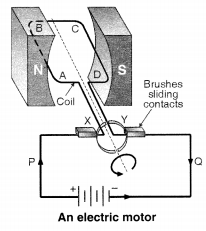
When the coil is in vertical position, the brushes X and Y would touch the centre of the commutator and the current in the coil is stopped. Though current is stopped but the coil comes back in horizontal state due to momentum.
After half rotation, the polarity of the commutator also changes, because now Q makes contact with brush X and P with brush Y. Therefore, now the force exerts downwards on the arm AB and upwards on the arm CD and thus again a couple of forces is formed that rotates the coil in clockwise direction. This process is repeated again and again and the coil rotates til! the current flows across it.
Function of split ring : Split ring in a motor acts as a commutator, i.e., it reverses the flow of current in the circuit due to which the direction of the forces acting on the arms also reverses.
Question 12
Name some devices in which electric motors are used.
Answer:
Electric motor is used in the appliances like electric fans, washing machine, mixers, grinders, blenders, computers, MP3 players, etc.
Question 13
A coil of insulated copper wire is connected to a galvanometer. What will happen if a bar magnet is (t) pushed into the coil (ii) withdrawn from inside the coil (iii) held stationary inside the coil ? [CBSE (Delhi) 2017, AICBSE 2016]
Answer:
(i) As a bar magnet is pushed into the coil, a momentary deflection is observed in the galvanometer indicating the production of a momentary current in the coil.
(ii) When the bar magnet is withdrawn from the coil, the deflection of galvanometer is in opposite direction showing the production of an opposite current.
(iii) When the bar magnet is held stationary inside the coil, there is no deflection in galvanometer indicating that no current is produced in the coil.
Question 14
Two circular coils A and B are placed closed to each other. If the current in the coil A is changed, will some current be induced in the coil B ? Give reason.
Answer:
Yes, some current will be induced in the coil B. When the current in coil A is changed, some current is induced in the coil B. Due to change in current in coil A, the magnetic field lines linked with coil A and with coil B get changed. This sets up induced current in coil B.
Question 15
State the rule to determine the direction of a (i) magnetic field produced around a straight conductor-carrying current (it) force experienced by a current-carrying straight conductor placed in a magnetic field which is perpendicular to it, and (in) current induced in a coil due to its rotation in a magnetic field.
Answer:
(i) Right hand thumb rule : If the current carrying conductor is held in the right hand such that the thumb points in the direction of the current, then the direction of the curl of the fingers will give the direction of the magnetic field.
(ii) Fleming’s left hand rule : NCERT Solutions for Class 10 Science Chapter 13 Magnetic Effects of Electric Current Stretch the forefinger, the central finger and the thumb of the left hand mutually perpendicular to each other. If the forefinger points in the direction of the magnetic field, the middle finger in the direction of current, then the thumb points in the direction of force in the conductor.
(iii) Fleming’s right hand rule : Stretch the thumb, forefinger and the central finger of the right hand mutually perpendicular to each other. If the forefinger points in the direction of magnetic field, thumb in the direction of motion of the conductor, then the middle finger points in the direction of current induced in the conductor.
Question 16
Explain the underlying principle and working of an electric generator by drawing a labelled diagram. What is the function of brushes ?
Answer:
Principle : The electric generator is based on the principle of electromagnetic induction. When a coil is rotated with respect to a magnetic field, the number of magnetic field lines through the coil changes. Due to this a current is induced in the coil whose direction can be found by Fleming’s right hand rule.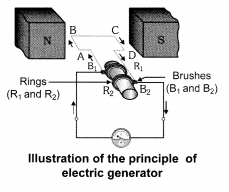
Working : When the armature coil ABCD rotates in a magnetic field produced by the permanent magnets, it cuts through the magnetic lines of force.
Due to the rotation of armature coil, the associated magnetic field changes and an induced electromagnetic force is produced in it. The direction of this induced electromotive force or current can be determined by using Fleming’s right hand rule.
In first half cycle the current flows in one direction by brush B1 and in second it flows in opposite direction by brush B2. This process continues. So the current produced is alternating in nature.
Functions of Brushes : Brushes in contact with rings provide the current for external use.
Question 17
When does an electric short circuit occur ?
Answer:
In a domestic circuit, short-circuit occurs when live and neutral wire come in direct contact with each other without any resistance. The resistance of the circuit becomes zero and excessive current starts to flow through it.
Question 18
What is the function of an earth wire ? Why is it necessary to earth metallic appliances ?
Answer:
Earth wire is a safety measure that provides a low resistance conducting path to the current. Sometimes due to excess heat or wear and tear, the live wire comes in direct contact with the metallic cover of the appliances, which can give an electric shock on touching them. To prevent from the shock the metallic part is connected to the earth through a three-pin plug due to which the current flows to the earth at the instant there is a short circuit.
It is necessary to earth metallic appliances because it ensures that if there is any current leakage in the metallic cover, the potential of the appliance becomes equal to that of the earth. The potential of the earth is zero. As a result, the person handling the appliance will not get an electric shock.
NCERT Solutions for Class 10 Science Chapter 13 Magnetic Effects of Electric Current
Magnetic effects of current: Magnetic field, field lines, field due to a current carrying conductor, field due to current carrying coil or solenoid; Force on current carrying conductor, Fleming’s left hand rule. Electromagnetic induction, Induced potential difference, Induced current, Fleming’s right hand rule, Direct current, Alternating current, frequency of AC, Advantage of AC over DC, Domestic electric circuits.
| Board | CBSE |
| Textbook | NCERT |
| Class | Class 10 |
| Subject | Science |
| Chapter | Chapter 13 |
| Chapter Name | Magnetic Effects of Electric Current |
| Number of Questions Solved | 39 |
| Category | NCERT Solutions |
Question 1
Why does a compass needle gets deflected when brought near a bar magnet?
Solution:
A compass needle is, in fact, a small bar magnet. If this is brought near another bar magnet, the like poles repel and the needle gets deflected.
Question 2
Draw magnetic field lines around a bar magnet?
Solution: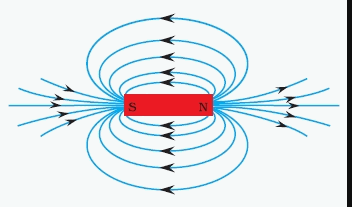
Question 3
List the properties of magnetic lines of force.
Solution:
a) Magnetic lines are directed from the north pole towards the south pole.
b) They do not cross each other.
c) They are more crowded near the poles than at any other region in the field.
d) They are closed curves.
e) In the uniform magnetic field, the lines of force are parallel to one another.
Question 4
Why don’t two magnetic lines of force intersect each other?
Solution:
No two field-lines are found to cross each other. If they did, it would mean that at the point of intersection, the compass needle would point towards two directions, which is not possible.
Question 5
Consider a circular loop of wire lying in the plane of the table. Let the current pass through the loop clockwise. Apply the right-hand rule to find out the magnetic field inside and outside the loop.
Solution:
At every point of a current –carrying loop, the concentric circles representing the magnetic field around it would become larger and larger as we move away from the wire. By the time we reach at the center of the circular loop, the arc of these big circles would appear as straight lines.
Question 6
The magnetic field in a given region is uniform. Draw a diagram to represent it.
Solution: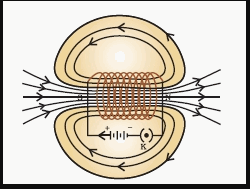
Question 7
The magnetic field inside a long straight solenoid-carrying current
a) is zero
b) decreases as we move towards its end
c) increases as we move towards its end
d) is the same at all points
Solution:
d) is the same at all points
Question 8
Which of the following property of a proton can change while it moves freely in a magnetic field?
a) Mass
b) Speed
c) Velocity
d) Momentum
Solution:
c) Velocity
d) Momentum.
Question 9
(a) Current in rod AB is increased?
(b) A stronger horseshoe magnet is used?
(c) Length of the rod AB is increased?
Solution:
(a) If the current in rod AB is increased, the displacement of rod AB will not be affected.
(b) If a stronger horseshoe magnet is used, force is exerted and hence the displacement increases.
(c) If the length of the rod AB is increased there is no change in the displacement of the rod AB.
Question 10
A positively-charged particle projected towards west is deflected towards north by a magnetic field. The direction of the magnetic field is
a) Towards south
b) Towards east
c) Downward
d) Upward
Solution:
b) Towards east.
Question 11
State Fleming’s left-hand rule.
Solution:
Fleming’s left-hand rule states that, stretch the thumb, fore finger and middle finger of the left hand such that they are mutually perpendicular. If the first finger points in the direction of magnetic field and the second finger in the direction of current, then the thumb will point in the direction of motion or the force acting on the conductor.
Question 12
What is the principle of an electric motor?
Solution:
Principle of an electric motor:
The working of the electric motor is based on the mechanical effect of an electric current. A conductor carrying a current placed in a magnetic field experiences a mechanical force.
In the motor, when a current is passed through a rectangular coil of wire placed in a magnetic field, the coil rotates continuously.
Question 13
What is the role of the split ring in an electric motor?
Solution:
In electric motor, the split ring acts as a commutator. A device that reverses the direction of flow of current through a circuit is called a commutator. The reversal of current also reverses the direction of force acting on the two arms AB and CD.
Question 14
Explain different ways to induce current in a coil.
Solution:
Current can be induced in a coil either by moving it in a magnetic field or by changing the magnetic field around it. The induced current is found to be the highest when the direction of motion of the coil is at right angles to the magnetic field. The process, by which a changing magnetic field in a conductor induces a current in another conductor, is called electromagnetic induction.
Question 15
State the principle of an electric generator.
Solution:
A generator is also known as a dynamo. It is a device used to convert mechanical energy in to electrical energy. The mechanical energy is used to rotate a conductor in a magnetic field to produce electricity. It is an application of electromagnetic induction.
An A.C generator generates an alternating current.
A D.C generator is used to deliver a current, which flows in the same direction.
Question 16
Name some source of direct current.
Solution:
The source of direct current is a split-ring type commutator, one brush is at all times in contact with the arm moving up in the field, while the other is in contact with the arm moving down. Thus a unidirectional current is produced.
Question 17
Which sources produce alternating current?
Solution:
The sources which produce alternating current is a permanent magnet called the field magnet, armature, slip ring and carbon brushes. After every half rotation the polarity of the current in the respective arms changes. Such a current, Which changes direction after equal intervals of time, is called an alternating current.
Question 18
A rectangular coil of copper wires is rotated in a magnetic field. The direction of the induced current changes once in each:
a) Two revolutions
b) One revolution
c) Half revolutions
d) One-fourth revolutions.
Solution:
b) One revolution.
Question 19
Name two safety measures commonly used in electric circuits and appliances.
Solution:
The use of an electric fuse prevents the electric circuits and appliance from a possible damage by passing the flow of unduly high electric current. The Joule heating that takes place in the fuse melts it to break the electric circuit.
Question 20
An electric oven of 2 KW power rating is operated in a domestic electric circuit (220 V) that has a current rating of 5 A. What result do you expect? Explain.
Solution:
V = 220 V, I = 5 A
Power, P = VI
P = 220 × 5
P = 1100 W
Therefore, power P = 1100 W = 1.1 KW
Therefore, an electric oven of 2 KW power rating cannot be operated in a domestic electric circuit (220 V) that has a current rating of 5 A because electric oven has higher power than the power of the electric circuit.
Question 21
What precaution should be taken to avoid the overloading of domestic electric circuits?
Solution:
Fuse is the most important safety device, to avoid the overloading of domestic electric circuits.
Too many appliances should not be connected to a single socket.
Question 22
Which of the following correctly describes the magnetic field near a long
straight wire?
(a) The field consists of straight lines perpendicular to the wire.
(b) The field consists of straight lines parallel to the wire.
(c) The field consists of radial lines originating from the wire.
(d) The field consists of concentric circles centred on the wire.
Solution:
(d) The field consists of concentric circles centred on the wire.
Question 23
The phenomenon of electromagnetic induction is
(a) the process of charging a body.
(b) the process of generating magnetic field due to a current passing through a coil.
(c) producing induced current in a coil due to relative motion between a magnet and the coil.
(d) the process of rotating a coil of an electric motor.
Solution:
(c) producing induced current in a coil due to relative motion between a magnet and the coil.
Question 24
The device used for producing electric current is called a
(a) generator.
(b) galvanometer.
(c) ammeter.
(d) motor.
Solution:
(a) generator.
Question 25
The essential difference between an AC generator and a DC generator is that:
(a) AC generator has an electromagnet while a DC generator has permanent magnet.
(b) DC generator will generate a higher voltage.
(c) AC generator will generate a higher voltage.
(d) AC generator has slip rings while the DC generator has a commutator
Solution:
(d) AC generator has slip rings while the DC generator has a commutator.
Question 26
At the time of short circuit, the current in the circuit
(a) reduces substantially.
(b) does not change.
(c) increases heavily.
(d) vary continuously.
Solution:
(c) increases heavily.
Question 27
State whether the following statements are true or false.
Solution:
(a) An electric motor converts mechanical energy into electrical energy – false.
(b) An electric generator works on the principle of electromagnetic induction – true
(c) The field at the centre of a long circular coil carrying current will be parallel straight lines – true.
(d) A wire with a green insulation is usually the live wire of an electric supply – true.
Question 28
List three sources of magnetic fields.
Solution:
a) Magnetic field due to a current through a straight conductor.
b) Magnetic field due to a current in a solenoid.
c) Magnetic field due to a current through a circular loop.
Question 29
How does a solenoid behave like a magnet? Can you determine the north and the south poles of a current-carrying solenoid with the help of a bar magnet? Explain.
Solution: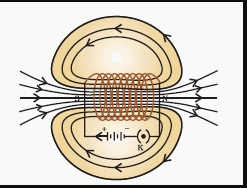
A coil of many circular turns of insulated copper wire wrapped closely in the shape of the cylinder is called a solenoid. The pattern of the magnetic field lines around a current- carrying solenoid is shown in this figure. In fact, one end of the solenoid behaves as a magnetic north pole, while the other behaves as the south pole. The field lines inside the solenoid are in the form of parallel straight lines. This indicates that the magnetic field is the same at all points inside the solenoid. That is, the field is uniform inside the solenoid.
A strong magnetic field produced inside a solenoid can be used to magnetise a piece of magnetic material, like soft iron, when placed inside the coil. The magnet so formed is called an electromagnet.
Question 30
When is the force experienced by a current-carrying conductor placed in a magnetic field the largest?
Solution:
The force experienced by a current-carrying conductor placed in a magnetic field is largest provided when the direction of current is at right angles to the direction of the magnetic field.
Question 31
Imagine that you are sitting in a chamber with your back to one wall. An electron beam, moving horizontally from back wall towards the front wall, is deflected by a strong magnetic field to your right side. What is the direction of magnetic field?
Solution:
The direction of magnetic field is towards west.
Question 32
Draw a labelled diagram of an electric motor. Explain its principle and working.What is the function of a split ring in an electric motor?
Solution: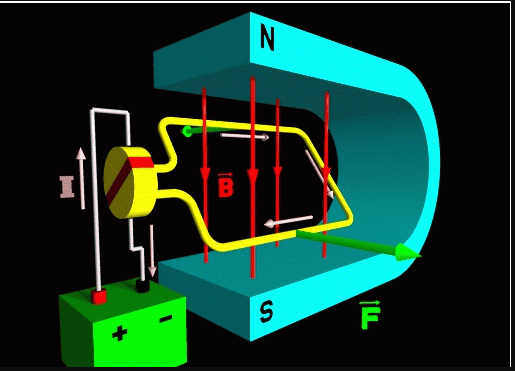
A motor is a device that converts the electrical energy into mechanical energy.
Principle
An electric motor is based on the fact that when a current carrying conductor is placed in a magnetic field the conductor experiences a force which is given by Fleming’s Left Hand Rule. For example, when a rectangular coil is placed in the magnetic field and current is passed through it, a torque acts on the coil, which rotates it continuously. When the coil rotates, the shaft attached to it also rotates and therefore the electrical energy supplied to the motor is converted into the mechanical energy of rotation.
An electrical motor consists of a rectangular coil ABCD of insulated copper wire, wound on a soft iron core called armature. The coil is mounted between the poles of a magnet in such a way that it can rotate between the poles N and S. The two ends of the coil are soldered to the ends of a commutator whose main function is to reverse the direction of the current flowing through the coil every time the coil just passes the vertical position during its revolution.
Working
Suppose the coil ABCD is initially at a horizontal position. When the switch is in ON position the current enters the coil through the carbon brushes and the half ring ‘A’ of the commutator.
The current flows in the direction DCBA and leaves via the half ring ‘B’. In the side PQ of the coil, the direction is from Q to P towards the south and the direction of the magnetic field is from the N to S pole towards the east. So, by applying Fleming’s left hand rule, we find that it will experience a force in upward direction. Similarly, the side SR of the coil will experience a downward force. Thus we have two parallel wires experiencing forces in opposite directions. They form a couple tending to rotate the coil in the anticlockwise direction.
When the coil goes beyond the vertical position, the two commutator half rings automatically changes contact from one brush to the other. This reverses the direction of current through the coil which, in turn, reverses the direction of forces acting on the two sides of the coil. The sides of the coil are interchanged, but rotate in the same anticlockwise direction. This process is repeated again and again and the coil continues to rotate as long as the current is passing.
Question 33
Name some devices in which electric motors are used.
Solution:
Electric fans, refrigerators, mixers, washing machines, computers, MP3 players etc are some devices in which electric motors are used.
Question 34
A coil of insulated copper wire is connected to a galvanometer. What will happen if a bar magnet is
(i) pushed into the coil,
(ii) withdrawn from inside the coil,
(iii) held stationary inside the coil?
Solution:
(i) A deflection is observed in the galvanometer due to the induced current because of the changing magnetic flux (increasing) through the turns of the coil connected to the galvanometer.
(ii) A deflection is again observed in the galvanometer, as when it is pulled out, the flux linked with the coil due to the bar magnet decreases. Hence a current flows in the coil to reduce the change in flux. The deflection can be observed in the opposite direction as compared with the previous case.
(iii) No deflection is observed in the galvanometer. The flux linked with the coil due to the magnetic field is at a constant. Hence no current is induced due to the bar magnet.
Question 35
Two circular coils A and B are placed closed to each other. If the current in the coil A is changed, will some current be induced in the coil B? Give reason.
Solution:
Yes, if the current in the coil A is changed, then some current will be induced in the coil B because due to the change in the magnetic field effect around the coils.
Question 36
State the rule to determine the direction of a
(i) magnetic field produced around a straight conductor-carrying current,
(ii) force experienced by a current-carrying straight conductor placed in a magnetic field which is perpendicular to it, and
(iii) current induced in a coil due to its rotation in a magnetic field.
Solution:
(i) Right-hand thumb rule
Imagine that we are holding a current carrying straight conductor in the right hand such that the thumb points towards the direction of current. Then our fingers will wrap around the conductor in the direction of the field lines of the magnetic field. This is known as Right-hand thumb rule.
(ii) Fleming’s left-hand rule
Fleming’s left-hand rule states that, stretch the thumb, fore finger and middle finger of the left hand such that they are mutually perpendicular. If the first finger points in the direction of magnetic field and the second finger in the direction of current, then the thumb will point in the direction of motion or the force acting on the conductor.
(iii) Fleming’s right-hand rule
If the thumb and the first two fingers of right hand are held at right angles to each other, with the Forefinger held in the direction of the field, and the thumb in the direction of motion, the induced current I flows in the direction of the middle finger.
Question 37
Explain the underlying principle and working of an electric generator by drawing a labelled diagram. What is the function of brushes?
Solution:
A C. generator
“A C. generator” means “Alternating Current generator”. That is, an A. C. generator produces alternating current, which alternates (changes) in polarity continuously. We will now describe the construction an working of the A. C. generator or A. C. dynamo.
Construction of an A. C. generator
A simple A. C. generator consists of a rectangular coil ABCD that can be rotated rapidly between the poles N and S of a strong horseshoe type magnet M. The coil is made of a large number of turns of insulated copper wire. The ends A and D of the rectangular coil are connected to two circular pieces of copper metal called slip rings R1 and R2. As the slip rings R1 and R2 rotate with the coil, the two pieces of carbon called brushes, B1 and B2, keep contact with them. So, the current produced in the rotating coil can be tapped out through slip rings into the carbon brushes. From the carbon brushes B1 and B2 we take the current into various electrical appliances like radio, T. V., electric iron, bulbs, etc. But in this figure, we have shown only a galvanometer G connected the two carbon brushes.
Working of an A. C. generator
Suppose that the generator coil ABCD is initially in the horizontal position. Again suppose that he coil ABCD is being rotated in the anticlockwise direction between the poles N and S of a horseshoe type magnet.
(i) As the coil rotates in the anticlockwise direction, the side AB of the coil moves down cutting the magnetic lines of force near the N-pole of the magnet, and side CD moves up, cutting the lines of force near the S-pole of the magnet. Due to this, induced current is produced in the sides AB and DC of the coil. On applying Fleming’s right hand rule to the side AB and DC of the coil, we find that the currents are in the direction B to A and D to C respectively. Thus, the induced currents in the two sides of the coil are in the same direction, and we get an effective induced current in the direction BADC.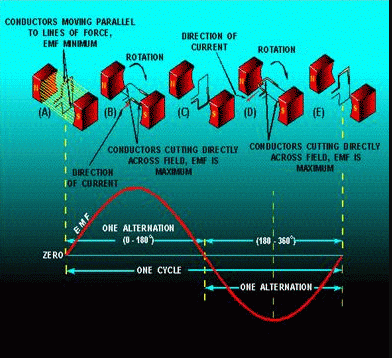
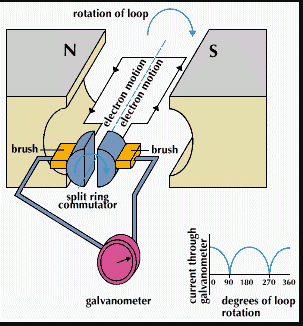
(ii) After half revolution, the sides AB and DC of the coil will interchange their positions. The side AB will come on the right hand side and DC will come on the left side. So, after half a revolution, side AB starts moving up and side DC starts coming down. As a result of this, the direction of induced current in each side of the coil is reversed after half a revolution. Since the direction of induced current in the coil is reversed after half revolution so the polarity (positive and negative) of the two ends of the coil also changes after half revolution. The end of coil which was positive in the first half of rotation becomes negative in the second in the second half. And the end which was negative in the first half revolution becomes positive in the second half of revolution. Thus, in 1 revolution of the coil, the current changes its direction 2 times.
The alternating current (A. C.) produced in India has a frequency of 50 Hz. That is, the coil is rotated at the rate of 50 revolutions per second. Since in 1 revolution of coil, the current changes its direction 2 times, so in 50 revolutions of coil, the current changes its direction 2 × 50 = 100 times. Thus, the A. C. supply in India changes its direction 100 times in 1 second. Another way of saying this is that the alternating current produced in India changes its direction every 1/100 second. That is, each terminal of the coil is positive (+) for 1/100 of a second and negative (-) for the next 1/100 of a second. This process is repeated again and again with the result that there is actually no positive and negative in an A. C. generator. We will now describe why the direction of induced current in the coil of an A. C. generator changes after every half revolution of the coil.
After every half revolution, each side of the generator coil starts moving in the opposite direction in the magnetic field. The side of the coil which was initially moving downwards in a magnetic field, after half revolution, it starts moving in opposite direction – upwards. Similarly the side of coil which was initially moving upwards, after half revolution, it starts moving downwards. Due to the change in the direction of motion of the two sides of the coil in the magnetic field after every half revolution, the direction of current produced in them also changes after every half revolution.
D. C. generator
“D. C. generator” means “Direct Current generator”. That is, a D. C. generator produces direct current and not alternating current. We will now describe the construction and working of D. C. generator or D. C. Dynamo.
Construction of a D. C. generator
A simple D. C. generator consists of a rectangular coil ABCD which cab be rotated rapidly between the poles N and S of a strong horse-shoe type magnet M. The generator coil is made of a large number of turns of insulated copper wire. The two ends of the coil are connected to the two copper half rings (or split rings) R1 and R2 of a commutator. There are two carbon brushes B1 and B2 which press lightly against the two half rings. When the coil is rotated, the two half rings R1 and R2 touch the two carbon brushes B1 and B2 one by one. So the current produced in the rotating coil can be tapped out through the commutator half rings into the carbon brushes. From the carbon brushes B1 and B2, we can take the current into the various electrical appliances like radio, T. V., electric iron, bulbs, etc. But in this figure, we have shown only a galvanometer G connected between the two carbon brushes. The galvanometer is a current detecting and current measuring instrument.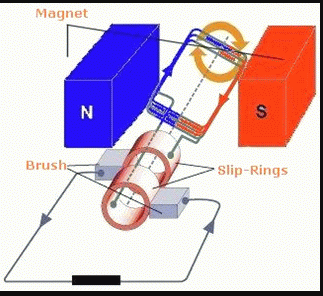
Working of a D. C. generator
Suppose that the generator coil ABCD is initially in the horizontal position. Again suppose that he coil ABCD is being rotated in the anticlockwise direction between the poles N and S of a horseshoe type magnet.
(iii) As the coil rotates in the anticlockwise direction, the side AB of the coil moves down cutting the magnetic lines of force near the N-pole of the magnet, and side DC moves up, cutting the lines of force near the S-pole of the magnet. Due to this, induced current is produced in the sides AB and DC of the coil. On applying Fleming’s right hand rule to the side AB and DC of the coil we find that the currents in them are in the direction B to A and D to C respectively. Thus, the induced currents in the two sides of the coil are in the same direction, and we get an effective induced current in the direction BADC. Due to this the brush B1 becomes a positive (+) pole and brush B2 becomes negative (-) pole of the generator.
(iv) After half revolution, the sides AB and DC of the coil will interchange their positions. The side AB will come on the right hand side and start moving up whereas side DC will come on then the two commutator half rings R1 and R2 automatically change their contacts from one carbon brush to the other. Due to this change, the current keeps flowing in the same direction in the other circuits. The brush B1 always remaining positive terminal and brush B2 always remaining negative terminal of the generator. Thus, a D. C. generator supplies a current in one direction by the use of a commutator consisting of two, half-rings of copper. In the above discussion we have used the word D. C. generator everywhere. Please note that we can also write D. C. dynamo in place of D. C. generator.
Question 38
When does an electric short circuit occur?
Solution:
Short circuiting
If the plastic insulation of the live wire and neutral wire gets torn, then the two wires touch each other. This touching of the live wire and neutral wire directly is known as short-circuiting. The current passing through the circuit formed by these wires is very large and consequently a high heating effect is created which may lead to fire.
Question 39
What is the function of an earth wire? Why is it necessary to earth metallic appliances?
Solution:
To avoid electric shocks, the metal body of an electrical device is ‘earthed’. A wire called ‘earth wire’ is used to connect the metal body of the electrical device to the earth, which is at zero potential. In household circuits, we have three wires, the live wire, the neutral wire and the earth wire. One end of the earth wire is connected to the device and the other end of the wire is connected to the earth. We now say that the device is “earthed” or “grounded”. Usually the three wires are connected to a three-pin plug. The neutral wire or the earth connection carries the high current to the earth from the device and prevents an electric shock.
Multiple Choice Questions (MCQs) [1 Mark each]
Question 1.
A compass is to be placed near a bar magnet with unknown poles. Outside the magnetic field, the compass needle is pointing towards North as shown below: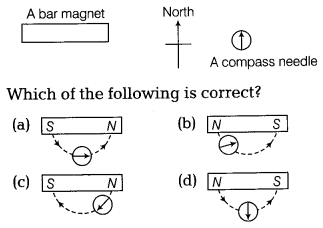
Answer:
(c) Magnetic field lines always point from North pole to South pole around the magnet. Thus, compass needle follows the path difference of magnetic field lines.
Question 2.
A bar magnet is broken into three parts X, Y and Z.
Which diagram show the poles in X, Y and Z?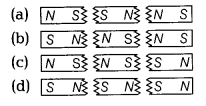
Answer:
(d) When a magnet is broken into three parts X, Y and Z, each part is still a magnet and the strength of the magnetic force remains the same.
Question 3.
An unmagnetised iron bar is placed near the end of a bar magnet.
Which of the following diagram is correct?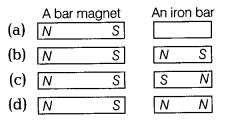
Answer:
(b) The end of the iron bar nearer to the South pole of the bar magnet becomes induced North pole while the other end is South pole.
Question 4.
The diagram shows a current-carrying wire passing through the centre of a square cardboard.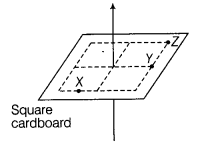
How do the strengths of the magnetic field at points X, Y and Z compare?
(a) equal at X, Y and Z
(b) stronger at Y than X, equal at Y and Z
(c) weaker at Y than Z, stronger at Y than Z
(d) stronger at Y than X, weaker at Z than X
Answer:
(d) The closer to the wire, the stronger is the magnetic field strength. Since, the magnetic field is circular. Y is the closest followed by X than Z.
Question 5.
A circular loop placed in a plane perpendicular to the plane of paper carries a current when the key is on.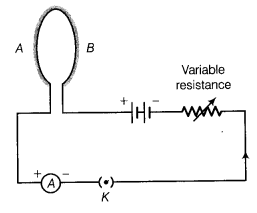
The current as seen from points A and B (in the plane of paper and on the axis of the coil) is anti-clockwise and clockwise, respectively.
The magnetic field lines point from B to A. The N-pole of the resultant magnet is on the face close to
(a) A
(b) B
(c) A if the current is small and B if the current is large
(d) B if the current is small and A if the current is large [NCERT Exemplar]
Answer:
(a) The N-pole of the resultant magnet is on the face close to A because, the magnetic field lines enter in loop from B and come out from A. Also, as a matter of fact magnetic lines come out of the N-pole of magnet. Therefore, face close to A represents N-pole. The currents in A and B are same.
Question 6.
A bar magnet is used to pick up an iron nail.
At which parts X, Y and Z is the easiest for the magnet to pick up the iron nail?
(a) At X
(b) AtY
(c) At Z
(d) It makes no difference
Answer:
(c) The region with the highest density of magnetic field lines has the greatest strength.
Question 7.
If the key in the arrangement as shown below is taken out (the circuit is made open) and magnetic field lines are drawn over the horizontal plane ABCD, the lines are [NCERT Exemplar]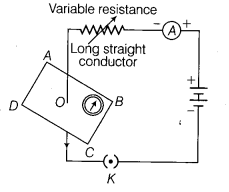
(a) concentric circles
(b) elliptical in shape
(c) straight lines parallel to each other
(d) concentric circles near the point O but of elliptical shapes as we go away from it
Answer:
(c) When the key is taken out (the circuit is made open), no current flows through the wire, hence no magnetic field exists due to the conductor.
The only magnetic field is due to Earth’s magnetic field and are straight lines parallel to each other. The horizontal component is directed from geographical South to geographical North on the horizontal plane ABCD.
Question 8.
Four metal rods are placed in turn inside the solenoid to attract paper clips.
The table below gives the results of the experiment when current is switched on and off.
Metalrod | When current is switched on, number of paper clips attracted | When current is switched off, number of paper clips still attracted |
| (a) | 1 | 0 |
| (b) | 20 | 2 |
| (c) | 35 | 0 |
| (d) | 35 | 30 |
Which rod would be the most suitable to use for the core of the solenoid in a circuit breaker?
Answer:
(c) The core of the solenoid in a circuit breaker must be made of a soft type magnetic material which can be strongly magnetised but does not retain induced magnetism.
Question 9.
Permanent magnets can be made using hard magnetic materials.
Which of the following is not the correct method to make permanent magnets?
(a) Using a bar magnet to stroke a steel bar
(b) Using two bar magnets to stroke a steel bar
(c) Placing a steel bar in a solenoid that connects to a DC supply
(d) Placing a steel bar in a solenoid that connects to an AC supply, then slowly withdrawing the steel bar away from the solenoid in West-East direction
Answer:
(d) The AC supply will mix up the direction of the magnetic domains. In fact, this is one of the methods to demagnetise magnets.
Question 10.
In the arrangement shown in figure, there are two coils wound on a non-conducting cylindrical rod. Initially, the key is not inserted. Then, the key is inserted and later removed. Then,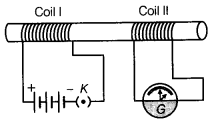
(a) the deflection in the galvanometer remains zero throughout.
(b) there is a momentary deflection in the galvanometer but it dies out shortly and there is no effect when the key is removed.
(c) there are momentary galvanometer deflections that die out shortly, the deflections are in the same direction.
(d) there are momentary galvanometer deflections that die out shortly, the deflections are in opposite directions. Thus, the galvanometer shows momentary deflections in opposite directions. [NCERT Exemplar]
Answer:
(d) In the given arrangement, whenever an electric current through the first coil is changed, an emf is induced in the coil due to change in magnetic field lines which pass through the neighbouring second coil. When key is inserted and removed, then the magnetic field lines passing through second coil increases and decreases in two cases respectively. Therefore, the direction of current in two cases is opposite. Thus, the galvanometer shows momentary deflections in opposite directions.
NCERT Solutions for Class 10 Science Chapter 13 Magnetic Effects of Electric Current (Hindi Medium)
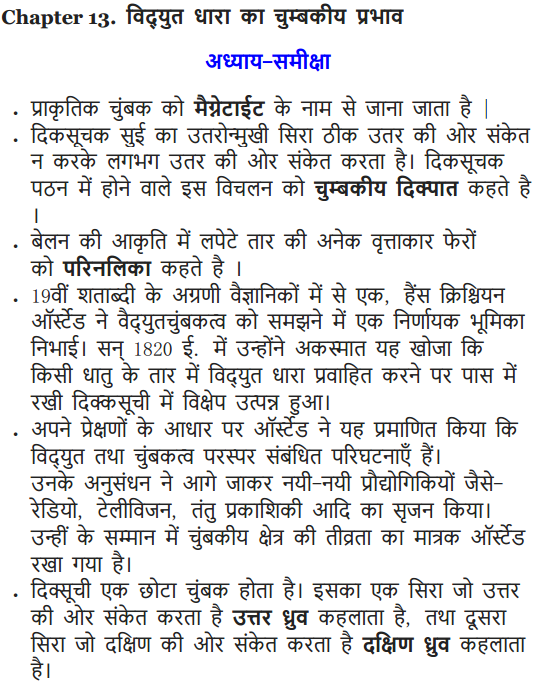
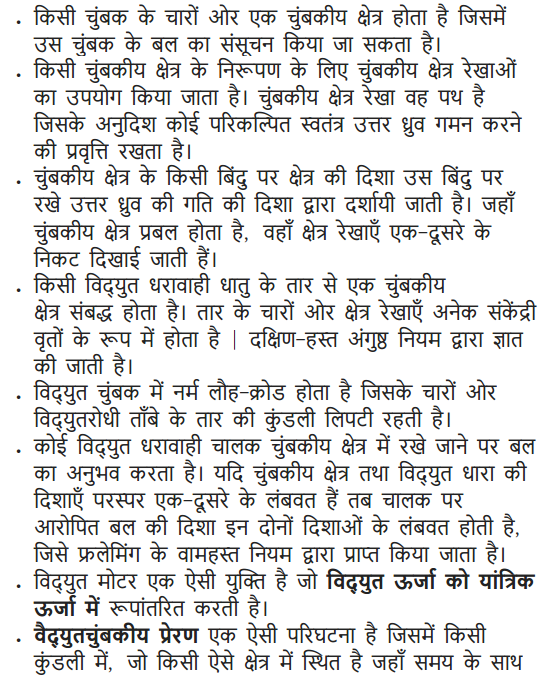
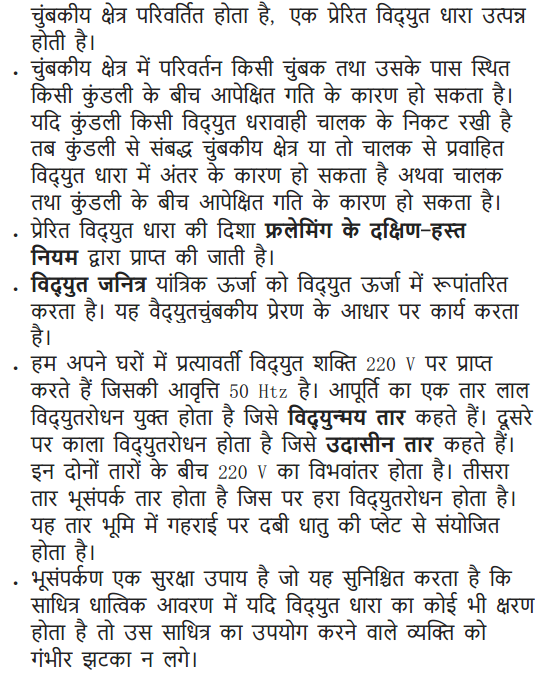
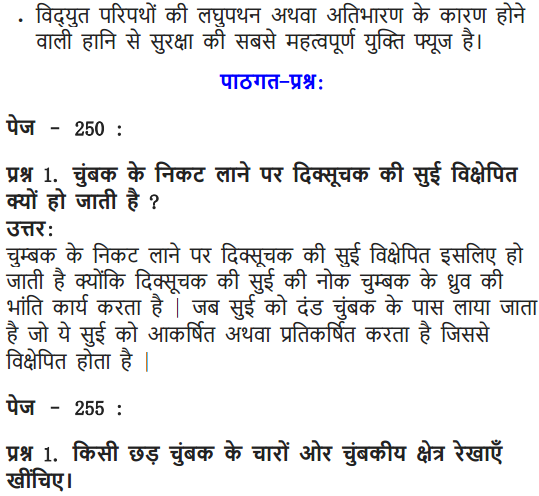
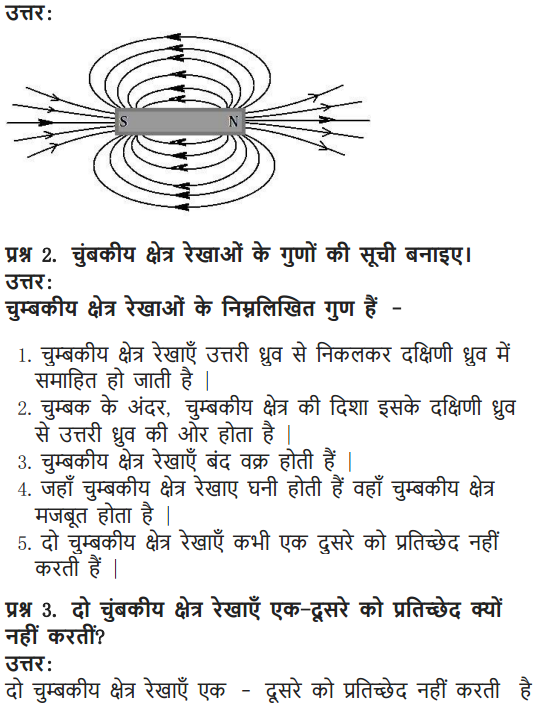
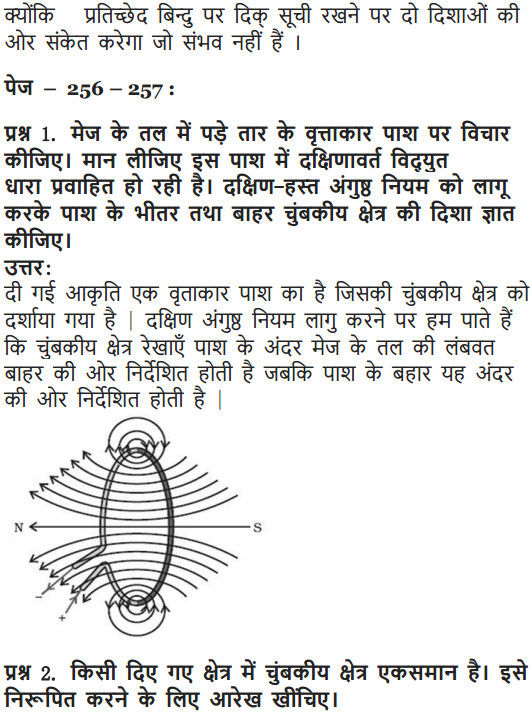
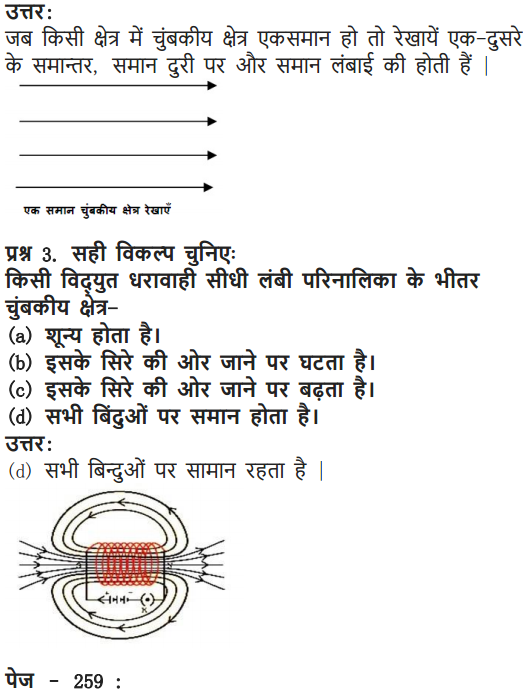
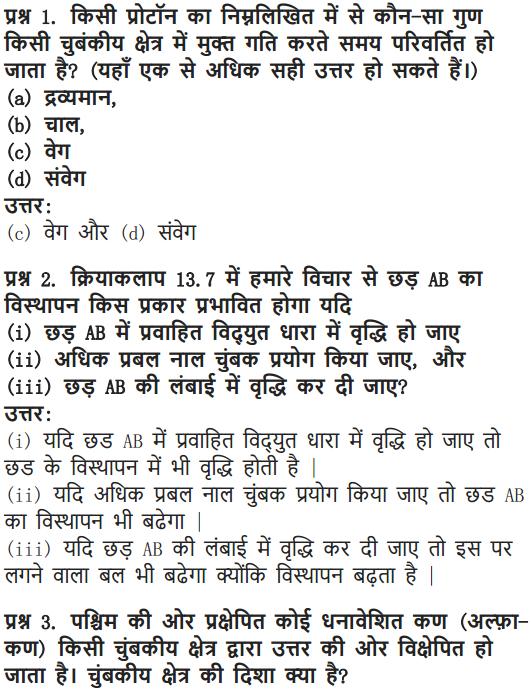
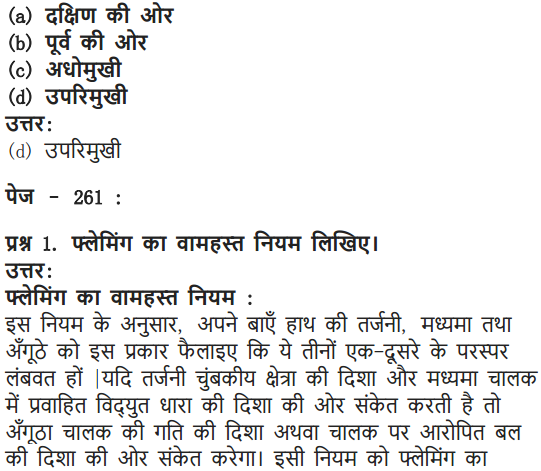
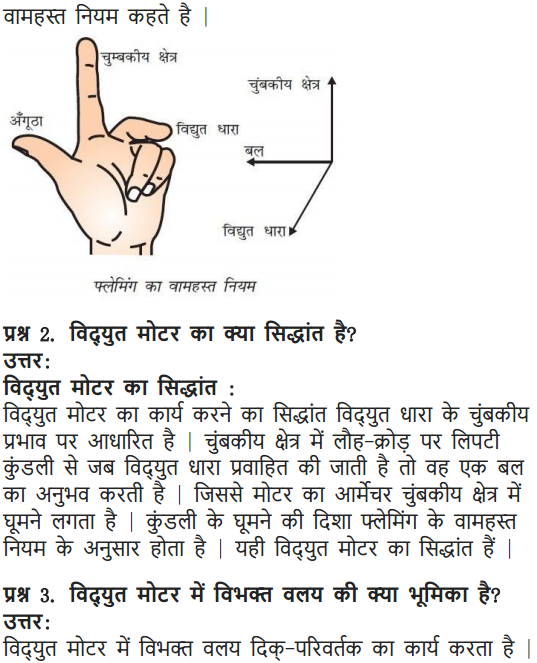
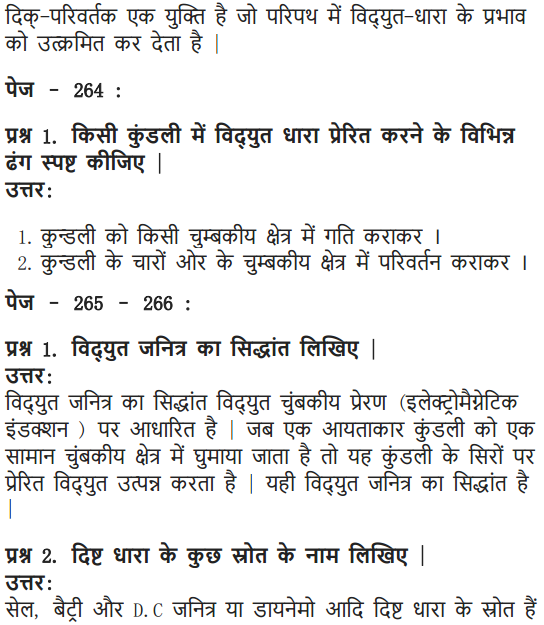
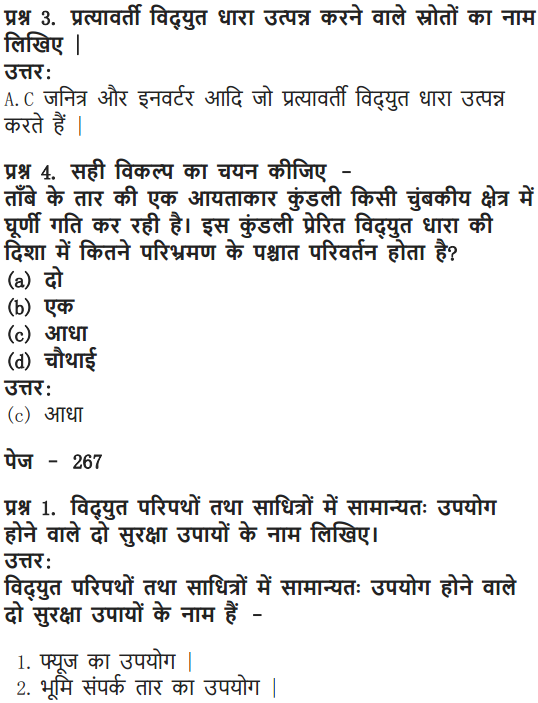
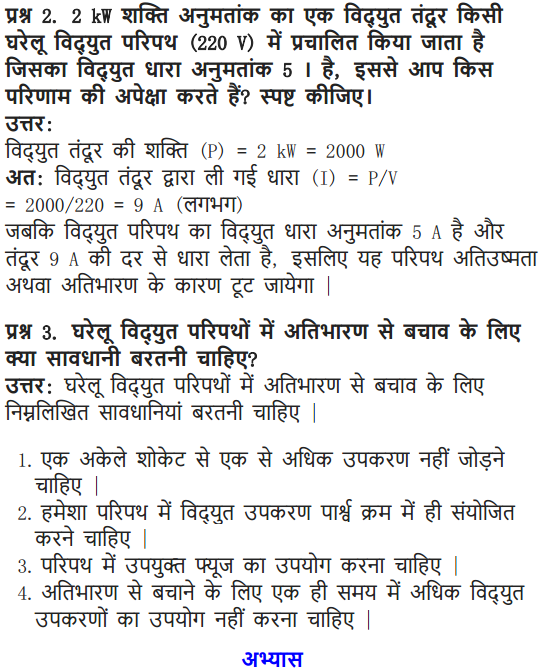
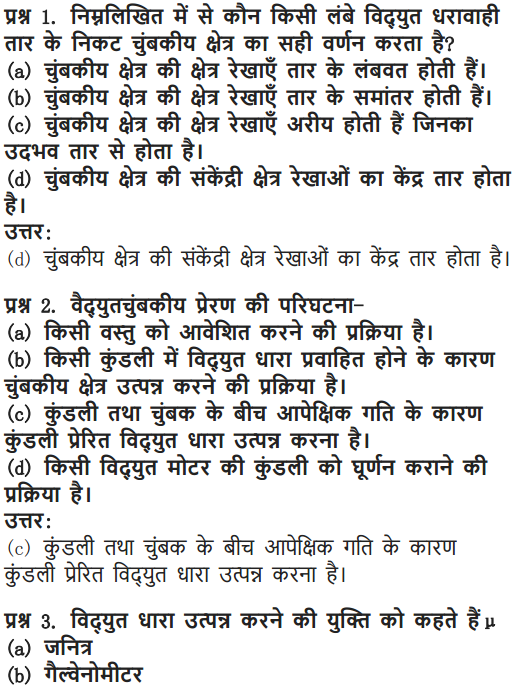
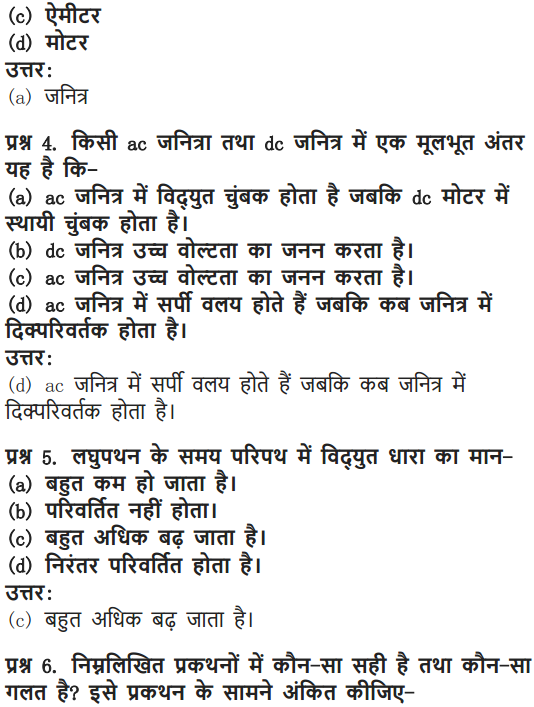
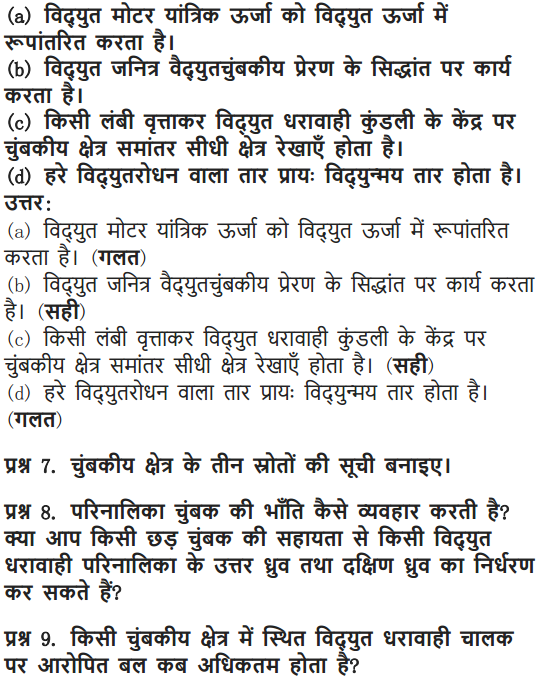
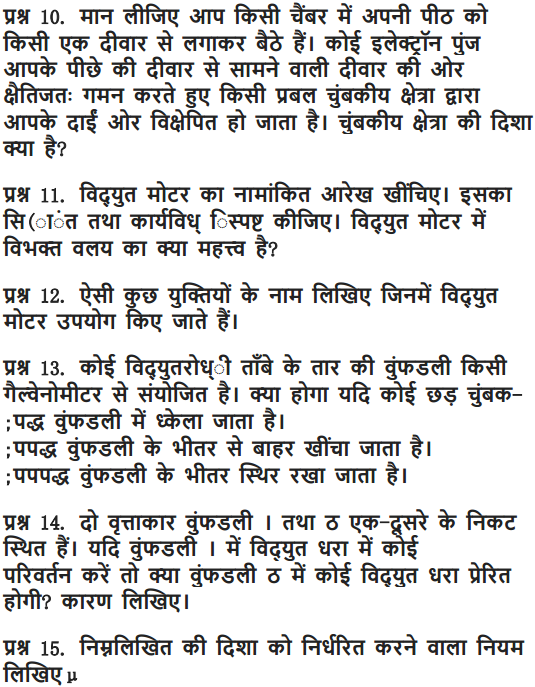
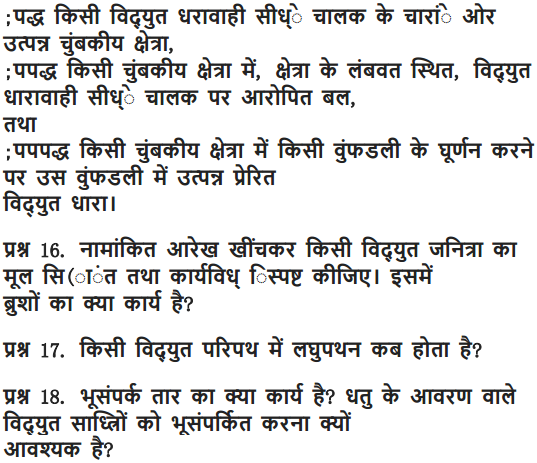
Class 10 Science Magnetic Effects of Electric Current Mind Map
Properties of Magnets
- Attractive property: Magnets attract magnetic materials like – iron, cobalt, nickel, etc
- Directive property: A freely suspended magnet always aligns in north- south direction
- Opposite poles attract and like poles repel.
- Poles exist in pairs North and South
- Repulsion is a sure test of magnet
Magnetic Field
Space around a magnet in which magnetic effect is experienced
Magnetic Field Lines
A line such that the tangent at any point on it gives the direction of the magnetic field at that point.
Properties of Magnetic Field Lines
- All field lines are closed curves.
- Field lines are close together near the poles.
- Two field lines never intersect each other.
Magnetic Field Due to a Current Carrying Conductor
The magnetic field around a straight conductor carrying current is in the form of closed circular loops, in a plane perpendicular to the conductor.
Direction of magnetic field can be determined by using Right hand thumb rule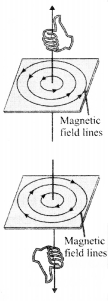
Solenoid
A solenoid is a long cylindrical helix, which produces a magnetic field when an electric current is passed through it.
The magnetic field within the solenoid is uniform and parallel to the axis of solenoid.
The magnetic field due to solenoid depends upon
(a) number of turns i.e., B ∝ n
(b) strength of current i.e, B ∝ I
(c) Nature of material inside solenoid i.e., B ∝ μ
Magnetic Field Due to a Circular Current Carrying Loop
At every’ point of a current carrying loop, the concentric circles representing the magnetic field around it would become larger as we move away.
Direction of magnetic field can be determined by using right hand rule
Force on a Current Carrying Conductor
The force experienced by the conductor
Direction of force can be determined by Fleming’s left hand rule, right hand palm or screw rule
Electromagnet
A solenoid with a soft iron core. A magnetic field is produced then an electric current flows through a coil of wire.
Uses
- For lifting and transporting large masses of iron scrap.
- For loading furnaces with iron.
- Electric bell, telegraph, electric motor, relay, loud speaker, microphone
- For separating magnetic substances such as iron from other debris
- In scientific research to study the magnetic properties of a substance in a magnetic field
Electric Motor
It converts electrical energy to mechanical energy.
It works on the principle of electromagnetic induction
Parts of Electric Motor
- Armature
- Field magnet
- Split-ring
- Commutator converts alternating voltage into direct voltage across the brushes.
- Brushes
- Battery
Uses
- The d.c. motors are used in d.c. fans
- They are used for pumping water
- Big d.c. motors are used for running tramcars and even trains
Electric Generator
- It converts mechanical energy to electrical energy.
- It works on the principle of electromagnetic induction
Parts of Electric Generator
- Armature
- Magnet
- Slip-rings
- Brushes
- Split ring type commutator for direct current generator
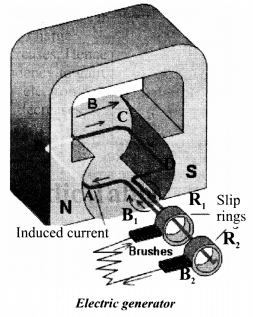
Types of Electric Generator
D.C. Generator
It is a type of generator which is used to produce induced current which flows in one direction
A.C. Generator
It generates alternating current that changes its polarity after every half rotation
Electromagnetic Induction
Voltage is induced by the relative motion between a wire and a magnetic field.
The amount of voltage induced depends on how fast the magnetic field lines are entering or leaving the coil.
Safety Devices
- When too much current flows or short circuit these devices breaks the circuit.
- They have less melting point.
- Fuses
- Miniature circuit breakers (MCBs)
Important Questions of Magnetic Effects of Electric Current Class 10 Science Chapter 13
Question 1.
What is meant by magnetic field?
Answer:
Magnetic field : It is defined as the space surrounding the magnet in which magnetic force can be experienced.
Question 2.
Draw magnetic field lines around a bar magnet. Name the device which is used to draw magnetic field lines. (Board Term I, 2015)
Answer: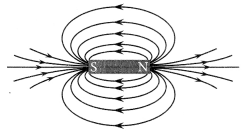
Compass needle is used to draw magnetic field lines.
Question 3.
Design an activity to demonstrate that a bar magnet has a magnetic field around it. (Board Term I, 2017)
Answer:
One can easily demonstrate the presence of field lines around a bar magnet using compass needles. Place the magnet on a white sheet and mark its boundaries on sheet. Place the compass near the north pole of magnet and mark the position of needle. Now move the compass such that its south pole occupies the position previously occupied by its north pole. Repeat this step several times and you will have pattern as shown in the figure.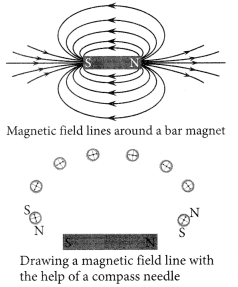
Repeat the above procedure and draw as many lines as you can. These lines represent the magnetic field around the magnet. These are known as magnetic field lines.
Question 4.
What are magnetic field lines? Justify the following statements:
(a) Two magnetic field lines never intersect each other.
(b) Magnetic field are closed curves. (Board Term I, 2016)
Answer:
Imaginary continuous closed curves used to represent the magnetic field in a region is known as magnetic field lines. It is directed from north pole to south pole outside the magnet and south pole to north pole inside the magnet.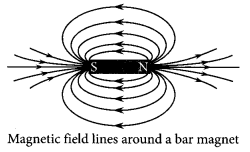
(a) The direction of magnetic field (B) at any point is obtained by drawing a tangent to the magnetic field line at that point. In case, two magnetic field lines intersect each other at the point P as shown in figure, magnetic field at P will have two directions, shown by two arrows, one drawn to each magnetic field line at P, which is not possible.
(b) It is taken by convention that the field lines emerges from north pole and merge at the south pole. Inside the magnet, the direction of field lines is from its south pole to its north pole. Thus, the magnetic field lines are closed curves.
Question 5.
(a) What is meant by a magnetic field? Mention two parameters that are necessary to describe it completely.
(b) If field lines of a magnetic field are crossed at a point, what does it indicate? (Board Term I, 2013)
Answer:
(a) Refer to answer 1.
Necessary parameters are:
- Magnitude of magnetic field.
- Direction of field lines
(b) If field lines of a magnetic field are crossed at a point, it indicates that there are two direction of magnetic field at a point which is not possible.
Question 6.
A compass needle is placed near a current carrying straight conductor. State your observation for the following cases and give reasons for the same in each case.
(a) Magnitude of electric current is increased.
(b) The compass needle is displaced away from the conductor. (AI 2019)
Answer:
(a) As the amount of magnetic field strength is directly proportional to the amount of current, so the deflection of compass needle increases.
(b) Since magnetic field strength at a point is inversely proportional to the distance from the wire. Hence deflection of compass decreases when it is displaced away from the conductor.
Question 7.
State how the magnetic field produced by a straight current carrying conductor at a point depends on
(a) current through the conductor
(b) distance of point from conductor. (Board Term I, 2014)
Answer:
Strength of magnetic field produced by a straight current-carrying wire at a given point is
(a) directly proportional to the current passing through it.
(b) inversely proportional to the distance of that point from the wire.
Question 8.
Give reason for the following
(i) There is either a convergence or a divergence of magnetic field lines near the ends of a current carrying straight solenoid.
(ii) The current carrying solenoid when suspended freely rests along a particular direction. (2/3, 2020)
Answer:
(i) There is either a convergence or a divergence of magnetic field lines near the ends of a current carrying straight solenoid because it behaves similar to that of a bar magnet and has a magnetic field line pattern similar to that of a bar magnet. Thus the ends of the straight solenoid behaves like poles of the magnet, where the converging end is the south pole and the diverging end is the north pole.
(ii) The current carrying solenoid behaves similar to that of a bar magnet and when freely suspended aligns itself in the north-south direction.
Question 9.
Find the direction of magnetic field due to a current carrying circular coil held:
(i) vertically in North – South plane and an observer looking it from east sees the current to flow in anticlockwise direction,
(ii) vertically in East – West plane and an observer looking it from south sees the current to flow in anticlockwise direction,
(iii) horizontally and an observer looking at it from below sees current to flow in clockwise direction .(Board Term I, 2017)
Answer:
According to right hand rule, the direction of magnetic field is
(i) west to east
(ii) north to south
(iii) into the paper.
Question 10.
(a) State three factors on which the strength of magnetic field produced by a current carrying solenoid depends.
(b) Draw circuit diagram of a solenoid to prepare an electromagnet. (Board Term I, 2016)
Answer:
(a) Strength of magnetic field produced by a current carrying solenoid depends upon the following factors:
- number of turns in the coil
- amount of current flowing through it
- radius of coil
- Material of core of the solenoid.
(b) A strong magnetic field produced inside a solenoid can be used to magnetise a piece of magnetic material, like soft iron, when placed inside the coil. The magnet so formed is called an electromagnet.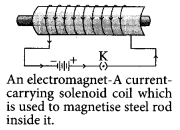
Question 11.
(a) State Right Hand Thumb rule to find the direction of the magnetic field around a current carrying straight conductor.
(b) How will the magnetic field be affected on:
(i) increasing the current through the conductor
(ii) reversing the direction of flow of current in the conductor? (Board Term I, 2015)
Answer:
(a) It states that you are holding a current carrying straight conductor in your right hand such that the thumb points towards the direction of current. Then your finger will wrap around the conductor in the direction of the field lines of the magnetic field.
(b) (i) If the current is increased, the magnetic field strength also increases.
(ii) If the direction of current is reversed, the direction of magnetic field also get reversed.
Question 12.
Diagram shows the lengthwise section of a current carrying solenoid. ⦻ indicates current entering into the page, ⨀ indicates current emerging out of the page. Decide which end of the solenoid A or B, will behave as north pole. Give reason for your answer. Also draw field lines inside the solenoid.
Answer: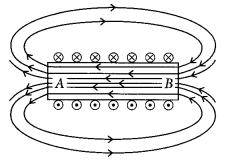
Using right hand thumb rube we can draw the magnetic field lines around the conductor as shown. From figure, end A of solenoid act as north pole and end B will act as south pole. Inside the solenoid field lines are in the form of parallel straight lines.
Question 13.
Write one application of right hand thumb rule. (1/3, Board Term I, 2013)
Answer:
It is used to find the direction of magnetic field around a current carrying conductor.
Question 14.
(a) What is an electromagnet? List any two uses.
(b) Draw a labelled diagram to show how an electromagnet is made.
(c) State the purpose of soft iron core used in making an electromagnet.
(d) List two ways of increasing the strength of an electromagnet if the material of the electromagnet is fixed. (2020)
Answer:
(a, b) Refer to answer 10(b).
Electromagnets are used in electric motors and generators, electric bells and buzzers, loudspeakers and headphones etc.
(c) The soft iron core placed in an electromagnet increases the strength of the magnetic field produced. Thus increasing the strength of electromagnet.
(d) The strength of electromagnet can be increased by
(i) Increasing the current passing through the coil.
(ii) Increasing the number of turns in the coil.
Question 15.
What is solenoid? Draw the pattern of magnetic field lines of
(i) a current carrying solenoid and
(ii) a bar magnet.
List two distinguishing features between the two fields. (Delhi 2019)
Answer:
(i) Solenoid : A coil of many circular turns of insulated copper wire wrapped in the shape of cylinder is called solenoid.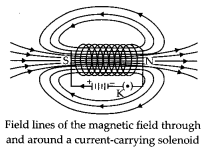
The pattern of magnetic field lines inside the solenoid indicates that the magnetic field is the same at all points inside the solenoid. That is, the field is uniform inside the solenoid.
(ii) Magnetic field lines around a bar magnet.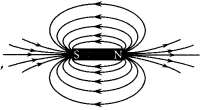
Following are the distinguishing features between the two fields.
(a) A bar magnet is a permanent magnet whereas solenoid is an electromagnet, therefore field produced by solenoid is temporary and stay till current flows through it.
(b) Magnetic field produced by solenoid is more stronger than magnetic field of a bar magnet.
Question 16.
What are magnetic field lines? List three characteristics of these lines. Describe in brief an activity to study the magnetic field lines due to a current carrying circular oil. (Board Term I, 2017, 2016)
Answer:
Magnetic field lines : These are the imaginary close curves which are used to represent the magnetic field around the magnet.
The properties of the magnetic field lines are listed below:
- Magnetic field lines start at the north pole and end at the south pole.
- Magnetic field lines do not intersect each other, because there cant be two directions of the magnetic field at any one point.
- The degree of closeness of the field lines depends upon the strength of the magnetic field. Stronger the field, closer are the field lines.
In order to find the magnetic field due to a coil, it is held in a vertical plane and is made to pass through a smooth cardboard in such a way that the centre (O) of the coil lies at the cardboard. A current is passed through the coil and iron filings are sprinkled on the cardboard. These iron filings arrange themselves in a pattern similar to one shown in the figure. This pattern represents the magnetic field lines due to the coil.
In order to find the direction of magnetic field lines, we plot the magnetic field with the help of a compass needle. The pattern of magnetic field lines so obtained is shown in figure (b). From this pattern, the following important conclusion have been drawn.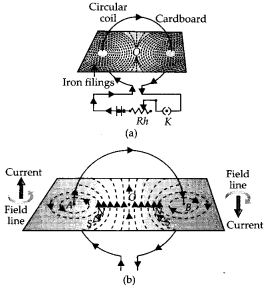
- The magnetic field lines near the coil are nearly circular and concentric. This is due to the reason that the segments of the coil in contact with the board at the points A and B are almost like straight conductors. The direction of the field lines can also be found by applying right-hand thumb rule.
- The field lines are in the same direction in the space enclosed by the coil.
- Near the centre of the coil, the field lines are nearly straight and parallel. As such the magnetic field at the centre of the coil can be taken to be uniform.
- The direction of the magnetic field at the centre is perpendicular to the plane of the coil.
- As we move towards the centre of the coil, the strength of magnetic field increases. Magnetic field is maximum at its centre. This is due to the reason that the two magnetic field (one due to the semicircular segment of the coil through A and the other due to the semicircular segment through B) assist each other.
The magnitude of the magnetic field at the centre of the coil is directly proportional to the current flowing through it and total number of turns and inversely proportional to the radius of the coil. This is due to the reason that the current in all the circular turns of the coil is in the same direction. As such, the resultant magnetic field due to the coil is equal to the sum of the field due to all these turns.
Question 17.
Draw the magnetic field lines through and around a single loop of wire carrying electric current. (2/5, Board Term I, 2016)
Answer: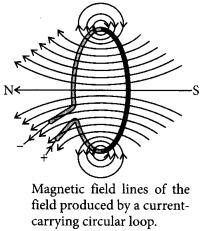
Question 18.
What is a solenoid? Draw a diagram to show field lines of the magnetic field through and around a current carrying solenoid. State the use of magnetic field produced inside a solenoid. List two properties of magnetic lines of force. (Board Term I, 2015)
Answer:
Refer to answer 15(i).
Solenoid is used to form strong but temporary magnet called electromagnets. These electromagnets are used in wide variety of instruments and used to lift heavy iron, objects.
Properties of magnetic filed lines :
Refer to answer 16.
Question 19.
State the effect of a magnetic field on the path of a moving charged particle. (Board Term I, 2014)
Answer:
A charged particle moving in a magnetic field may experience a force in the direction perpendicular to direction of magnetic field and direction of motion of particle. This force deflects the charged particle from its path.
Question 20.
State the direction of magnetic field in the following case.
Answer:
Using Fleming’s left hand rule, the direction of magnetic field is out of the plane of paper.
Question 21.
Write one application of Flemings left hand rule. (1/3, Board Term I, 2013)
Answer:
Flemings left hand rule is used to find the direction of force on a current carrying conductor placed in a magnetic field acting perpendicular to the direction of current.
Question 22.
A current carrying conductor is placed in a magnetic field. Now answer the following.
(i) List the factors on which the magnitude of force experienced by conductor depends.
(ii) When is the magnitude of this force maximum?
(iii) State the rule which helps, in finding the direction of motion of conductor.
(iv) If initially this force was acting from right to left, how will the direction of force change if:
(a) direction of magnetic field is reversed?
(b) direction of current is reversed? (Board Term I, 2017)
Answer:
(i) When a current carrying wire is placed in a magnetic field, it experiences a magnetic force that depends on
(a) current flowing in the conductor
(b) strength of magnetic field
(c) length of the conductor
(d) angle between the element of length and the magnetic field.
(ii) Force experienced by a current carrying conductor placed in a magnetic field is largest when the direction of current is perpendicular to the direction of magnetic field.
(iii) The rule used in finding the direction of motion of the conductor placed in a magnetic field is Flemings left hand rule.
Fleming’s left hand rule is as follows:
Stretch out the thumb, the forefinger, and the second (middle) finger of the left hand so that these are at right angles to each other. If the forefinger gives the direction of the magnetic field (N to S), the second (middle) finger the direction of current then the thumb gives the direction of the force acting on the conductor.
(iv) (a) Direction of force will be reversed when direction of magnetic field is reversed, i.e., now force on conductor will act from left to right.
(b) Direction of force will be reversed, if the direction of current is reversed, i.e., the force on the conductor will act from left to right.
Question 23.
State whether an alpha particle will experience any force in a magnetic field if (alpha particles are positively charged particles)
(i) it is placed in the field at rest.
(ii) it moves in the magnetic field parallel to field lines.
(iii) it moves in the magnetic field perpendicular to field lines.
Justify your answer in each case. (Board Term I, 2016)
Answer:
(i) No, alpha particle will not experience any force if it is at rest, because only moving charge particle can experience force when placed in a magnetic field.
(ii) No, alpha particle will not experience any force if it moves in the magnetic field parallel to field lines because charge particle experiences force only when it moves at an angle other than 0° with magnetic field.
(iii) Alpha particle will experience a force in the direction perpendicular to the direction of magnetic field and direction of motion of alpha particle.
Question 24.
Describe an activity with labelled diagram to show that a force acts on current carrying conductor placed in a magnetic field and its direction of current through conductor. Name the rule which determines the direction of this force. (Board Term I, 2016)
Answer:
A small aluminium rod suspended horizontally from a stand using two connecting wires. Place a strong horseshoe magnet in such a way that the rod lies between the two poles with the magnetic field directed upwards. For this, put the north pole of the magnet vertically below and south pole vertically above the aluminium rod.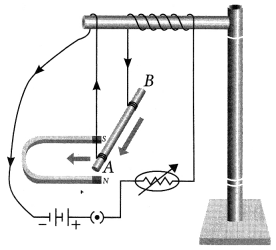
Connect the aluminium rod in series with a battery, a key and a rheostat. Pass a current through the aluminium rod from one end to other (B to A). The rod is displaced towards left. When the direction of current flowing through the rod is reversed, the displacement of rod will be towards right. Direction of force on a current carrying conductor is determined by Fleming’s left hand rule.
Question 25.
(a) State Flemings left hand rule.
(b) Write the principle of working of an electric motor.
(c) Explain the function of the following parts of an electric motor.
(i) Armature (ii) Brushes (iii) Split ring (2018)
Answer:
(a) Refer to answer 22 (iii).
(b) Principle : Current carrying conductor when placed at right angle to a magnetic field, experiences a force due to which we get motion. The direction of the force is given by Flemings left hand rule.
(c) (i) Armature is a conductive part of motor which generates torque in the motor.
(ii) The two stationary brushes in a simple electric motor draw current from the battery and supply it to the armature of motor.
(iii) The role of split ring is to change the direction of current flowing through the coil after each half-rotation of coil.
Question 26.
The change in magnetic field lines in a coil is the cause of induced electric current it. Name the underlying phenomenon. (2020)
Answer:
The phenomenon in which electric current is generated by varying magnetic fields around a coil is called electromagnetic induction.
Question 27.
Define the term induced electric current. (2020)
Answer:
The current induced in a conductor when the magnetic field around it changes is known as induced electric current.
Question 28.
Flemings Right-hand rule gives
(a) magnitude of the induced current.
(b) magnitude of the magnetic field.
(c) direction of the induced current.
(d) both, direction and magnitude of the induced current. (2020)
Answer:
(c) Flemings Right-hand rule gives the direction of induced current.
Question 29.
What is the function of a galvanometer in a circuit? (Delhi 2019)
Answer:
Galvanometer is an instrument that can detect the presence of electric current in a circuit.
Question 30.
Write any one method to induce current in a coil. (Board Term I, 2016)
Answer:
By keeping the magnet in a fixed position and moving the coil towards and away from the magnet, we can induce current in the coil.
Question 31.
Two coils of insulated copper wire are wound over a non-conducting cylinder as shown. Coil 1 has comparatively large number of turns. State your observations, when
(i) Key K is closed
(ii) Key K is opened
Give reason for each of your observations. (2020)
Answer:
(i) When key is closed, after setting up the circuit as shown, one can observe a deflection on the galvanometer connected to the second coil. This is because, a potential difference and thus a current is induced in coil 2 as there is change in the current and the magnetic field associated with it in coil 1. When the magnetic field changes in coil 1, the magnetic field lines around coil 2 also changes. This induces a current in coil 2.
(ii) When key K is opened, after closing it for sometime it can be observed that the galvanometer show a deflection, but this time in the opposite direction. This is because, when the current stops flowing in coil 1, the magnetic field associated with it changes in the opposite direction as in the first case, thus inducing a current in the opposite direction.
Question 32.
Two circular coils P and Q are kept close to each other, of which coil P carries a current. What will you observe in the galvanometer connected across the coil Q
(a) if current in the coil P is changed?
(b) if both the coils are moved in the same direction with the same speed?
Give reason to justify your answer in each
Answer:
(a) When the amount of current in the coil P is changed, an induced current will induce in the coil Q due to change in magnetic field lines i.e., magnetic flux.
(b) If both the coils are moved in the same direction with the same speed, then there is no net change in magnetic flux. Hence there will be no deflection in the galvanometer.
Question 33.
In Faradays experiment if instead of moving the magnet towards the coil we move the coil towards the magnet. Will there be any induced current? Justify your answer. Compare the two cases. (Board Term I, 2017)
Answer:
Yes, these will be an induced current in both the cases as there is a change in the number of magnetic field line associated with the coil or we can say that there is a motion of a magnet with respect to the coil.
Same of current will be induced and the direction of flow of current will also be the same in the two cases.
Question 34.
Write one application of Fleming’s right hand rule. (1/3, Board Term I, 2013)
Answer:
Flemings right hand rule is used to find the direction of induced current.
Question 35.
(a) A coil of insulated copper wire is connected to a galvanometer. With the help of a labelled diagram state what would be seen if a bar magnet with its south pole towards one face of this coil is
(i) moved quickly towards it,
(ii) moved quickly away from it,
(iii) placed near its one face?
(b) Name the phenomena involved in the above cases.
(c) State Fleming’s right hand rule. (Board Term I, 2017)
Answer:
(a) If a coil of insulated wire is connected to a galvanometer and a bar magnet with south pole is moved towards one face of the coil then, given situation is shown in the figure.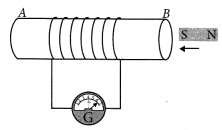
(i) Moved quickly towards the coil : A current is induced in clockwise direction in the coil with respect to the side facing the north pole of the magnet and needle of galvanometer will deflect in one direction from zero position.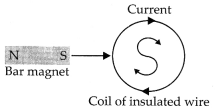
(ii) Moved quickly away from coil : A current is induced in anti-clockwise direction in the coil with respect to the side facing the north pole of the magnet and the needle of the galvanometer will deflect in opposite direction from (i).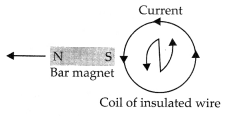
(iii) Placed near its one face : No deflection of the needle of galvanometer is observed.
(b) The phenomena involved is called electromag-netic induction.
(c) Fleming’s right hand rule: Stretch the right hand such that the first finger, the central finger and the thumb are mutually perpendicular to each other.
If the first finger points along the direction of the field (magnetic field) and the thumb points along the direction of motion of the conductor, then the direction of induced current is given by the direction of the central finger.
Question 36.
Write the frequency of alternating current (AC) in India. How many times per second it changes its direction? (Board Term I, 2015)
Answer:
The frequency of A.C. in India is 50 Hz and it changes direction twice in each cycle. Therefore, it changes direction 2 × 50 = 100 times in one second.
Question 37.
How is the type of current that we receive in domestic circuit different from the one that runs a clock? (Board Term I, 2014)
Answer:
The current that we receive from domestic circuit is alternating current (A.C.) and the current that issuse to run clock is direct current (D.C.). Direct current always flow in one direction whereas the alternating current reverses its direction periodically.
Question 38.
Define alternating current and direct current.
Explain why alternating current is preferred over direct current for transmission over long distances. (Board Term I, 2014)
Answer:
Alternating current (A.C.) : An electric current whose magnitude changes with time and direction reverses periodically is called alternating current.
Direct current (D.C.) : An electric current whose magnitude is either constant or variable but the direction of flow in a conductor remains the same is called direct current.
A.C. can be transmitted to distant places without much loss of electric power than D.C. That is why A.C. is preferred over D.C. for transmission of current over a long distances.
Question 39.
(i) Alternating current has a frequency of 50 Hz. What is meant by this statement? How many times does it change its direction in one second? Give reason for your answer.
(ii) Mention the frequency of D.C that is given by a cell. (Board Term I, 2013)
Answer:
(i) The frequency of household supply of A.C. in India is 50 Hz. This means, A.C. completes 50 cycles in one second. Thus, A.C. changes direction 2 × 50 = 100 times in one second.
(ii) Frequency of D.C. is zero as its direction does not change with time.
Question 40.
At the time of short circuit, the electric current in the circuit.
(a) vary continuously (b) does not change
(c) reduces substantially
(d) increases heavily. (2020)
Answer:
(d) At the time of short circuit, the live and neutral wire come in direct contact, thus increasing the current in the circuit abruptly.
Question 41.
Mention and explain the function of an earth wire. Why it is necessary to earth metallic appliances? (Board Term I, 2013)
Answer:
Many electric appliances of daily use like electric press, heater, toaster, refrigerator, table fan etc. have a metallic body. If the insulation of any of these appliances melts and makes contact with the metallic casing, the person touching it is likely to receive a severe electric shock. This is due to the reason that the metallic casing will be at the same potential as the applied one. Obviously, the electric current will flow through the body of the person who touches the appliance. To avoid such serious accidents, the metal casing of the electric appliance is earthed. Since the earth does not offer any resistance, the current flows to the earth through the earth wire instead of flowing through the body of the person.
Question 42.
Give reason for the following :
The burnt out fuse should be replaced by another fuse of identical rating. (1/3, 2020)
Answer:
A burnt out fuse should be replaced with identical rating because it helps in protecting the circuit from overloading and short circuiting. If a fuse of higher rating is used then it may not melt and cut off the supply during overloading. Similarly a fuse of lower rating may melt frequently even for a normal flow of current. This results in decreasing the efficiency of the circuit.
Question 43.
Give reasons for the following:
(a) It is dangerous to touch the live wire of the main supply rather than neutral wire.
(b) In household circuit, parallel combination of resistances is used.
(c) Using fuse in a household electric circuit is important. (Board Term I, 2017)
Answer:
(a) Live wire is at 220V and neutral wire is at zero volt since the electric current flows from higher potential to lower potential, we can get an electric shock by touching live wire but that is not the case with neutral wire.
(b) In parallel combination, each resistor gets same potential from the source. We can use separate on/off switches with each appliance. Also in case if any one resistor fails then the circuit will not break. So, it is safe and convenient to connect household circuit in parallel combination of resistors
(c) Fuse is an important safety device. It is used in series with any electrical appliance and protects it from short-circuiting and overloading.
Question 44.
(a) Fuse acts like a watchman in an electric circuit. Justify this statement.
(b) Mention the usual current rating of the fuse wire in the line to (i) lights and fans (ii) appliance of 2 kW or more power. (Board Term I, 2014)
Answer:
(a) When an unduly high electric current flows through the circuit, the fuse wire melts due to joule heating effect and breaks the circuit. Hence, it keeps an eye on the amount of current flowing and also stops the current if exceeds the maximum value. So, fuse acts like a watchman in an electric circuit.
(b) (i) A fuse of rating 5A is usually used for lights and fans.
(ii) A fuse of rating 15 A is usually used for appliance of 2 kW or more power.
Question 45.
(a) State Fleming’s Left-hand rule.
(b) List three characteristic features of the electric current used in our homes.
(c) What is a fuse? Why is it called a safety device?
(d) Why is it necessary to earth metallic electric appliances? (2020)
Answer:
(a) Refer to answer 22(iii).
(b) (i) The electric current which we receive in our homes are alternating current with a frequency of 50 Hz.
(ii) There are mainly two wires used in the power supply provided to us. The one usually with a red insulation is called the live wire (or positive wire) and the one with black insulation is called the neutral wire (or negative wire). The potential difference between these wires is 220 V.
(iii) Often, there are two separate circuits used in our homes, one of 15 A current rating for appliances with higher power rating and the other circuit of 5 A rating for appliances such as fans, bulbs, etc.
(c) A fuse is safety device use to limit the current in an electric circuit.
Refer to answer 44(a).
(d) Refer to answer 41.
Question 46.
(a) Name two safety measures commonly used in an electric circuit and appliances.
(b) What precaution should be taken to avoid the overloading of domestic electric circuits? (Board Term I, 2017)
Answer:
(a) Fuse and the connection of earthing wire are the two safety measure commonly used in electric circuit and appliances.
(b) Provide fuses/MCBs of proper rating.
Question 47.
(a) Draw a schematic diagram of a common domestic circuit showing provision of
(i) Earth wire, (ii) Main fuse
(iii) Electricity meter and
(iv) Distribution box.
(b) Distinguish between short circuiting and overloading. (Board Term I, 2015)
Answer: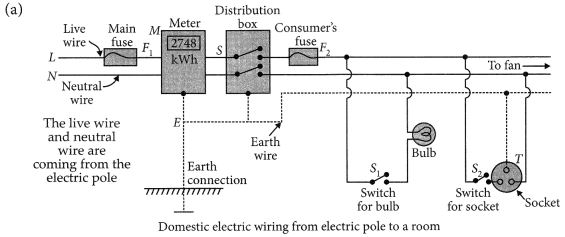
(b) Overloading : The condition in which a high current flows through the circuit and at the same time too many appliances are switched on then the total current drawn through the circuit may exceed its rated value.
CBSE Class 10 Science Notes Chapter 13 Magnetic Effects of Electric Current
Magnet: Magnetic field and magnetic field lines, Magnetic field due to a current carrying conductor, Right hand thumb rule, Magnetic field due to current through a circular loop. Magnetic field due to current in a solenoid.
Magnet is an object that attracts objects made of iron, cobalt and nickle. Magnet comes to rest in North – South direction, when suspended freely.
Use of Magnets: Magnets are used
- in refrigerators.
- in radio and stereo speakers.
- in audio and video cassette players.
- in children’s toys and;
- on hard discs and floppies of computers.
Properties of Magnet
- A free suspended magnet always points towards the north and south direction.
- The pole of a magnet which points toward north direction is called north pole or north-seeking.
- The pole of a magnet which points toward south direction is called south pole or south seeking.
- Like poles of magnets repel each other while unlike poles of magnets attract each other.
Magnetic field: The area around a magnet where a magnetic force is experienced is called the magnetic field. It is a quantity that has both direction and magnitude, (i.e., Vector quantity).
Magnetic field and field lines: The influence of force surrounding a magnet is called magnetic field. In the magnetic field, the force exerted by a magnet can be detected using a compass or any other magnet.
The magnetic field is represented by magnetic field lines.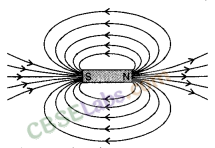
The imaginary lines of magnetic field around a magnet are called field line or field line of magnet. When iron fillings are allowed to settle around a bar magnet, they get arranged in a pattern which mimicks the magnetic field lines. Field line of a magnet can also be detected using a compass. Magnetic field is a vector quantity, i.e. it has both direction and magnitude.
Direction of field line: Outside the magnet, the direction of magnetic field line is taken from North pole to South Pole. Inside the magnet, the direction of magnetic field line is taken from South pole to North pole.
Strength of magnetic field: The closeness of field lines shows the relative strength of magnetic field, i.e. closer lines show stronger magnetic field and vice – versa. Crowded field lines near the poles of magnet show more strength.
Properties of magnetic field lines
(i) They do not intersect each other.
(ii) It is taken by convention that magnetic field lines emerge from North pole and merge at the South pole. Inside the magnet, their direction is from South pole to North pole. Therefore magnetic field lines are closed curves.
Magnetic field lines due to current a current carrying straight conductor
A current carrying straight conductor has magnetic field in the form of concentric circles, around it. Magnetic field of current carrying straight conductor can be shown by magnetic field lines.
The direction of magnetic field through a current carrying conductor depends upon the direction of flow electric current.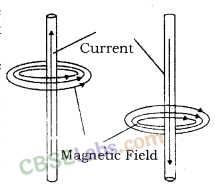
Let a current carrying conductor be suspended vertically and the electric current is flowing from south to north. In this case, the direction of magnetic field will be anticlockwise. If the current is flowing from north to south, the direction of magnetic field will be clockwise.
The direction of magnetic field, in relation to direction of electric
current through a straight conductor can be depicted by using the Right Hand Thumb Rule. It is also known as Maxwell’s Corkscrew Rule.
Right-Hand Thumb Rule: If a current carrying conductor is held by right hand, keeping the thumb straight and if the direction of electric current is in the direction of thumb, then the direction of wrapping of other fingers will show the direction of magnetic field.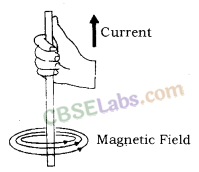
Maxwell’s Corkscrew rule: As per Maxwell’s Corkscrew Rule, if the direction of forward movement of screw shows the direction of the current, then the direction of rotation of screw shows the direction of magnetic field.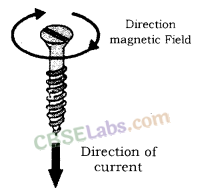
Properties of magnetic field
- The magnitude of magnetic field increases with increase in electric current and decreases with decrease in electric current.
- The magnitude of magnetic field produced by electric current decreases with increase in distance and vice – versa. The size of concentric circles of magnetic field lines increases with distance from the conductor, which shows that magnetic field decreases with distance.
- Magnetic field lines are always parallel to each other.
- No two field lines cross each other.
Magnetic field lines due to a current through a circular loop
In case of a circular current carrying conductor, the magnetic field is produced in the same manner as it is in case of a straight current carrying conductor.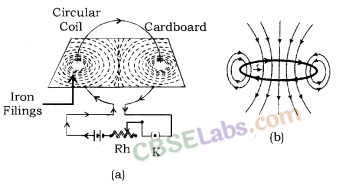
In case of a circular current carrying conductor, the magnetic field lines would be in the form of iron concentric circles around every part of the FllmSs periphery of the conductor. Since, magnetic field lines tend to remain closer when near to the conductor, so the magnetic field would be stronger near the periphery of the loop. On the other hand, the magnetic field lines would be distant from each other when we move towards the centre of the current carrying loop. Finally, at the centre, the arcs of big circles would appear as a straight line.
The direction of the magnetic field can be identified using Right Hand Thumb’s Rule. Let us assume that the current is moving in anti-clockwise direction in the loop. In that case, the magnetic field would be in clockwise direction, at the top of the loop. Moreover, it would be in an anti-clockwise direction at the bottom of the loop.
Clock Face Rule: A current carrying loop works like a disc magnet. The polarity of this magnet can be easily understood with the help of Clock Face Rule. If the current is flowing in anti – clockwise direction, then the face of the loop shows north pole. On the other hand, if the current is flowing in clockwise direction, then the face of the loop shows south pole.
Magnetic field and number of turns of coil: Magnitude of magnetic field gets summed up with increase in the number of turns of coil. If there are ‘n’ turns of coil, magnitude of magnetic field will be ‘n’ times of magnetic field in case of a single turn of coil.
The strength of the magnetic field at the centre of the loop(coil) depends on :
(i) The radius of the coil: The strength of the magnetic field is inversely proportional to the radius of the coil. If the radius increases, the magnetic strength at the centre decreases
(ii) The number of turns in the coil : As the number of turns in the coil increase, the magnetic strength at the centre increases, because the current in each circular turn is having the same direction, thus, the field due to each turn adds up.
(iii) The strength of the current flowing in the coil: As the strength of the current increases, the strength of three magnetic fields also increases.
Magnetic field due to a current in a Solenoid: Solenoid is the coil with many circular turns of insulated copper wire wrapped closely in the shape of a cylinder. A current carrying solenoid produces similar pattern of magnetic field as a bar magnet. One end of solenoid behaves as the north pole and another end behaves as the south pole.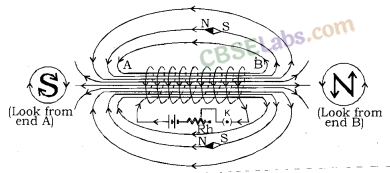
Magnetic field lines are parallel inside the solenoid, similar to a bar magnet, which shows that magnetic field is same at all points inside the solenoid.
Magnetic field produced by a solenoid is similar to a bar magnet.
The strength of magnetic field is proportional to the number of turns and magnitude of current.
By producing a strong magnetic field inside the solenoid, magnetic materials can be magnetized. Magnet formed by producing magnetic field inside a solenoid is called electromagnet.
Electromagnet, Fleming’s Left-Hand Rule, Electric motor, Electromagnetic induction, Fleming’s right hand rule, Electric generator and domestic electic circuits.
Electromagnet: An electromagnet consists of a long coil of insulated copper wire wrapped on a soft iron.
Magnet formed by producing magnetic field inside a solenoid is called electromagnet.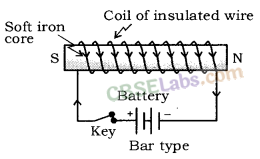
Force on a current carrying conductor in a magnetic field: A current carrying conductor exerts a force when a magnet is placed in its vicinity. Similarly, a magnet also exerts equal and opposite force on the current carrying conductor. This was suggested by Marie Ampere, a French Physicist and considered as founder of science of electromagnetism.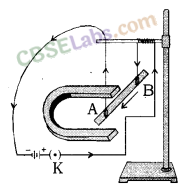
The direction of force over the conductor gets reversed with the change in direction of flow of electric current. It is observed that the magnitude of force is highest when the direction of current is at right angles to the magnetic field.
Fleming’s Left-Hand Rule: If the direction of electric current is perpendicular to the magnetic field, the direction of force is also perpendicular to both of them. The Fleming’s Left Hand Rule states that if the left hand is stretched in a way that the index finger, the middle finger and the thumb are in mutually perpendicular directions, then the index finger and middle finger of a stretched left hand show the direction of magnetic field and direction of electric current respectively and the thumb shows the direction of motion or force acting on the conductor. The directions of electric current, magnetic field and force are similar to three mutually perpendicular axes, i.e. x, y, and z-axes.
Many devices, such as electric motor, electric generator, loudspeaker, etc. work on Fleming’s Left Hand Rule.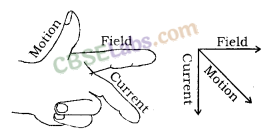
Electric motor: A device that converts electrical energy to mechanical energy. It is of two types : AC and DC Motor.
Electrical energy is converted into mechanical energy by using and electric motor. Electric motor works on the basis of rule suggested by Marie Ampere and Fleming’s Left Hand Rule.
Principle of Electric Motor: When a rectangular coil is placed in a magnetic field and a current is passed through it, force acts on the coil, which rotates it continuously. With the rotation of the coil, the shaft attached to it also rotates.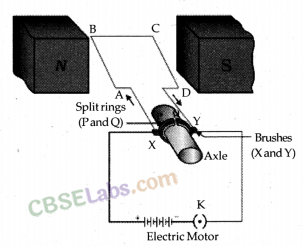
Construction: It consists of the following parts :
- Armature: It is a rectangular coil (ABCD) which is suspended between the two poles of a magnetic field.
The electric supply to the coil is connected with a commutator. - Commutator or Split – ring: Commutator is a device which reverses the direction of flow of electric current through a circuit. It is two halves of the same metallic ring.
- Magnet: Magnetic field is supplied bv a permanent magnet NS.
- Sliding contacts or Brushes Q which are fixed.
- Battery: These are consists of few cells.
Working: When an electric current is supplied to the coil of the electric motor, it gets deflected because of magnetic field. As it reaches the halfway, the split ring which acts as commutator reverses the direction of flow of electric current. Reversal of direction of the current, reverses the direction of forces acting on the coil. The change in direction of force pushes the coil, and it moves another half turn. Thus, the coil completes one rotation around the axle. Continuation of this process keeps the motor in rotation.
In commercial motor, electromagnet instead of permanent magnet and armature is used. Armature is a soft iron core with large number of conducting wire turns over it. Large number of turns of conducting wire enhances the magnetic field produced by armature.
Uses of motors :
- Used in electric fans.
- Used for pumping water.
- Used in various toys.
Electromagnetic Induction: Michael Faraday, an English Physicist is supposed to have studied the generation of electric current using a magnetic field and a conductor.
Electricity production as a result of magnetism (induced current) is called Electromagnetic Induction.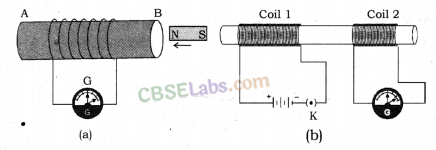
When a conductor is set to move inside a magnetic field or a magnetic field is set to be changing around a conductor, electric current is induced in the conductor. This is just opposite to the exertion of force by a current carrying conductor inside a magnetic field. In other words, when a conductor is brought in relative motion vis – a – vis a magnetic field, a potential difference is induced in it. This is known as electromagnetic induction.
Fleming’s Right-Hand Rule: Electromagnetic induction can be explained with the help of Fleming’s Right Hand Rule. If the right hand is structured in a way that the index (fore ginger) finger, middle finger and thumb are in mutually perpendicular directions, then the thumb shows direction of induced current in the conductor, in conductor The directions of movement of conductor, magnetic field and induced current can be compared to three mutually perpendicular axes, i.e. x, y and z axes.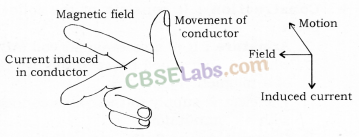
The mutually perpendicular directions also point to an important fact that when the magnetic field and movement of conductor are perpendicular, the magnitude of induced current would be maximum.
Electromagnetic induction is used in the conversion of kinetic energy into electrical energy.
Electric Generator: A device that converts mechanical energy into electrical energy is called an electric generator.
Electric generators are of two types: AC generator and a DC generator. Principle of electric generator: Electric motor works on the basis of electromagnetic induction.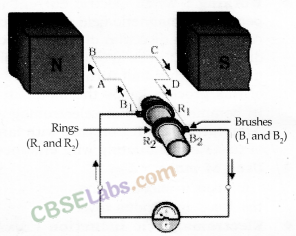
Construction and Working: The structure of an electric generator is similar to that of an electric motor. In case of an electric generator, a rectangular armature is placed within the magnetic field of a permanent magnet. The armature is attached to wire and is positioned in a way that it can move around an axle. When the armature moves within the magnetic field, an electric current is induced. The direction of induced current changes, when the armature crosses the halfway mark of its rotation.
Thus, the direction of current changes once in every rotation. Due to this, the electric generator usually produces alternate current, i.e. A.C. To convert an A.C generator into a D.C generator, a split ring commutator is used. This helps in producing direct current.
Electrical generator is used to convert mechanical energy into electrical energy.
A.C and D.C Current
A.C – Alternate Current: Current in which direction is changed periodically is called Alternate Current. In India, most of the power stations generate alternate current. The direction of current changes after every 1/100 second in India, i.e. the frequency of A.C in India is 50 Hz. A.C is transmitted upto a long distance without much loss of energy is advantage of A.C over D.C.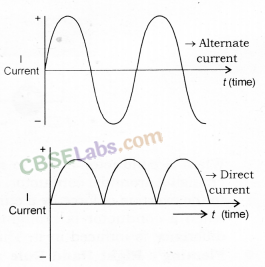
D.C – Direct Current: Current that flows in one direction only is called Direct current. Electrochemical cells produce direct current.
Advantages of A.C over D.C
- Cost of generatior of A.C is much less than that of D.C.
- A.C can be easily converted to D.C.
- A.C can be controlled by the use of choke which involves less loss of power whereas, D.C can be controlled using resistances which involves high energy loss.
- AC can be transmitted over long distances without much loss of energy.
- AC machines are stout and durable and do not need much maintenance.
Disadvantages of AC
- AC cannot be used for the electrolysis process or showing electromagnetism as it reverses its polarity.
- AC is more dangerous than DC.
Domestic Electric Circuits: We receive electric supply through mains supported through the poles or cables. In our houses, we receive AC electric power of 220 V with a frequency of 50 Hz.
The 3 wires are as follows
- Live wire – (Red insulated, Positive)
- Neutral wire – (Black insulated, Negative)
- Earth wire – (Green insulated) for safety measure to ensure that any leakage of current to a metallic body does not give any serious shock to a user.
Short Circuit: Short-circuiting is caused by the touching of live wires and neutral wire and sudden a large current flows.
It happens due to
- damage pf insulation in power lines.
- a fault in an electrical appliance.
Overloading of an Electric Circuit: The overheating of electrical wire in any circuit due to the flow of a large current through it is called overloading of the electrical circuit.
A sudden large amount of current flows through the wire, which causes overheating of wire and may cause fire also.
Electric Fuse: It is a protective device used for protecting the circuit from short-circuiting and overloading. It is a piece of thin wire of material having a low melting point and high resistance.
- Fuse is always connected to live wire.
- Fuse is always connected in series to the electric circuit.
- Fuse is always connected to the beginning of an electric circuit.
- Fuse works on the heating effect.
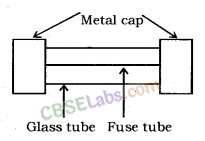
Magnetic field: The area around a magnet in which other magnet feels force of attraction or repulsion is called Magnetic field.
Magnetic field lines: The closed curved imaginary lines in the magnetic field which indicate the direction of motion of north pole in the magnetic field if a magnet is free to do so.
Properties of magnetic field lines.
- Magnetic Field lines originate from the north pole of a magnet and end at its south pole.
- Magnetic Field lines are denser near the poles but rarer at other places.
- The Magnetic Field lines do not intersect one another.
Oersted’s experiment: According to this experiment “A current carrying wire creates a magnetic field around it. The direction of magnetic field depends on the direction of current in conductor.”
- Magnetic field pattern due to straight current carrying conductor are concentric circles whose center lie on the wire.
- The direction of magnetic field due to straight current carrying conductor can be determined by Right hand thumb rule.
Right hand thumb rule: According to this rule “if current carrying conductor is held in the right hand in such a way that thumb indicate the direction of current, then the curled finger indicates the direction of magnetic field lines around conductor.”
Magnetic field pattern due to current carrying loop: The Magnetic field lines are circular near the current-carrying loop. As we move away from the loop, field lines form bigger and bigger circles. At the center of the circular loop, the magnetic field lines are straight.
The solenoid is an insulated and tightly wound long circular wire having large number of turns whose radius is small in comparison to its length. Magnetic field produced by a solenoid is similar to the magnetic field produced by a bar magnet.
Current carrying solenoid is called an electromagnet.
Properties of magnetic lines of force or magnetic field lines.
- These lines originate from the north pole and end at the south pole.
- The magnetic field lines of a magnet form a continuous closed loop.
- Two magnetic lines of force do not intersect each other.
- The tangent at any point on the magnetic line gives the direction of the magnetic field at the point.
Fleming’s left hand rule: According to this rule, “if the thumb, forefinger and middle finger of the left hand are stretched perpendicular to each other and if the fore-finger gives the direction of magnetic field, middle finger gives the direction of current, then the thumb will give the direction of motion or the force acting on the current-carrying conductor.”
Principle of an electric motor: A motor works on the principle that when a rectangular coil is placed in a magnetic field and current passes through it, a force acts on the coil which rotates it continuously.
When the coil rotates, the shaft attached to it also rotates. In this way the electrical energy supplied to the motor is converted into the mechanical energy of rotation.
Principle of an electric generator: It is based on the principle of electromagnetic induction. It states that “an induced current is produced in a coil placed in a region where the magnetic field changes with time.” The direction of induced current is given by Fleming’s right-hand rule. An electric generator converts mechanical energy into electrical energy.
Electromagnetic induction: The phenomenon of setting up of an electric current or an induced e.mi. by changing the magnetic lines of force by a moving conductor is called electromagnetic induction.
Maxwell’s right hand thumb rule: The direction of the current is given by Maxwell’s right-hand thumb rule, “If the current carrying conductor is gripped with the right hand in such a way that the thumb gives the direction of the current, then the direction of the fingers gives the direction of the magnetic field produced around the conductor.
Fleming’s left-hand rule: The direction of motion of a conductor in a magnetic field is given by Fleming’s left-hand rule. According to this rule, if the thumb, forefinger and middle finger of the left hand are stretched perpendicular to each other and if fore-finger gives the direction of the magnetic field and the middle finger gives the direction of current then, the thumb will give the direction of the motion of the conductor carrying the current.
Fleming’s right-hand rule: The direction of the induced current is given by Fleming’s right-hand rule. According to this rule if the thumb, forefinger and middle finger of the right hand are stretched perpendicular to each other and if the fore-finger gives the direction of the magnetic field and the thumb gives the direction of motion, then the middle finger will give the direction of the induced current in the conductor.
NCERT Exemplar Class 10 Science Chapter 13 Magnetic Effects of Electric Current
Short Answer Type Questions
1.A magnetic compass needle is placed in the plane of paper near point A as shown in figure. In which plane should a straight current carrying conductor be placed so that it passes through A and there is no change in the deflection of the compass? Under what condition is the deflection maximum and why?
Answer. In the given situation, a straight current-carrying conductor should be placed in the plane of paper. The held produced by it is perpendicular to the plane of paper and parallel to the vertical axis of compass needle. As a result there will be no change in the deflection of compass needle.
The deflection is maximum when the straight current carrying conductor through the point A is perpendicular to the plane of paper so that field due to it is parallel to the plane of paper.
2. Under what conditions permanent electromagnet is obtained if a current carrying solenoid is used? Support your answer with the help of a labelled circuit diagram.
Answer. Required conditions are:
(i) The magnitude of direct current through the solenoid should be large.
(ii)The number of turns in the solenoid should be large and closely packed, so that a strong uniform magnetic field inside it is produced.
(iii) The rod kept inside is made of a magnetic material such as steel.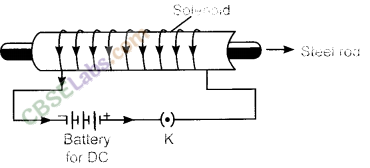
3.AB is a current carrying conductor in the plane of the paper as shown in figure. What are the directions of magnetic fields produced by it at points P and Q? Given r1 > r2, where will the strength of the magnetic field be larger?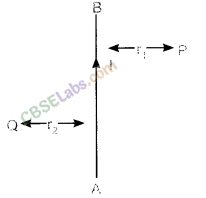
Answer. Apply right hand thumb rule, the direction of magnetic field produced by a current carrying conductor at Point P – into the plane of paper
Point Q – out of the plane of paper.
As magnetic field is inversely proportional to distance, the field at Q will be larger than the field at P ( r1 > r2).
4.It is established that an electric current through a metallic conductor produces a magnetic field around it. Is there a similar magnetic field produced around a thin beam of moving (i) alpha particles, (ii) neutrons? Justify your answer.
Answer.
(i) Yes, similar magnetic field is produced around a thin beam of moving a-particle. a-particle being positively charged constitutes a current in the direction of beam motion.
(ii) No, neutron being electrically neutral, does not constitute a current.
5.Name four appliances wherein an electric motor, a rotating device that converts electrical energy to mechanical energy, is used as an important component. In what respect motors are different from generators?
Answer.The four appliances wherein electric motor, a rotating device that converts electrical energy into mechanical energy is used are electric fan, water pump, grinder and washing machine.
Difference between electric motor and generator:
Electric Motor | Electric Generator |
(a) It converts electrical energy into mechanical energy. | (a) It converts mechanical energy into electrical energy. |
| (b) It works on the principle of magnetic effect of electric | (b) It works on the phenomenon of electromagnetic induction. |
6.What is the role of the two conducting stationary brushes in a simple electric motor?
Answer.The two stationary conducting brushes make the contact in between the two halves of the split rings and the source battery. Current in the coil enters from the source battery through one conducting brush and flows back to the battery through another brush.
Long Answer Type Question
1.Why does a magnetic compass needle pointing North and South in the absence of a nearby magnet get deflected when a bar magnet or a current carrying loop is brought near it. Describe some salient features of magnetic lines of field concept.
Answer.Both the bar magnet or a current carrying loop have their own magnetic field. These external magnetic fields modify the earth’s existing magnetic field. This resultant magnetic field deflects the magnetic compass needle by exerting a magnetic force on it, from its original north-south direction.
Features of magnetic field lines are: ‘
- Magnetic field lines represent the magnetic field around the magnetic substance or current carrying conductor. They have both direction and magnitude.
- The field lines emerge from North pole and merge at South pole. Inside the magnet their direction is from south pole to north pole. Hence magnetic field lines are a continuous closed curve.
- The degree of closeness of the field lines is relative to the strength of magnetic field. Strong magnetic field is indicated by crowded field lines or vice versa.
- No two magnetic field lines intersect each other. If they intersect, the compass needle would point towards two different directions at a point, which is impossible.
- The parallel and equidistant field lines in a given region indicate the presence of a uniform magnetic field in that region whereas converging or diverging field lines represent the non-uniform magnetic field.
Extra Questions – Magnetic Effects of Electric Current – CBSE Class 10 Science
According to new CBSE Exam Pattern, MCQ Questions for Class 10 Science pdf Carries 20 Marks.
Question-1
Define a solenoid. Compare the magnetic field produced by a solenoid with that of a bar magnet?
Solution:
A coil of many circular turns of wire wrapped in the shape of a cylinder, is called a solenoid. The magnetic field lines in a solenoid, through which current is passed, is very similar to that of a bar magnet. One end of the coil acts like a magnetic north pole, while the other acts like a south pole. The magnetic field produced by a long solenoid has all the properties of the field produced by a bar magnet.
Question-2
Give one important advantage of AC over DC
Solution:
A.C can be stepped up and stepped down which means that the voltage can be increased or decreased. Hence it can be transmitted to long distances without much loss of energy. So A.C is preferred over D.C.
Question-3
Give the circuit symbol for a fuse. Explain its importance in a circuit.
Solution:
A fuse is a very important device used for protecting electric circuits. It is a wire made out of a metal like tin or tin alloy having a very low melting point. When a high current flows through a circuit, the fuse wire gets heated or melts due to short circuiting or overloading. Hence the circuit is broken and the current stops flowing. This saves all the appliances of the circuit.
Fuse wires are of various capacities. A fuse with 5 ampere capacity will be thinner than a fuse with 15 ampere capacity. A fuse of 5 amps is used in circuits where lights and fans are connected whereas a fuse of 15 amps is used in power circuits where appliances like electric heater, geyser, electric iron and air conditioner are connected.
Question-4
Give a note on Magnetism in Human beings.
Solution:
Whenever there is an electric current, there is a magnetic field. Even the extremely weak ion currents that travel along the nerve cells in our body produce magnetic fields. When we try to touch something, our nerves carry an electric impulse to the muscles we need to use. This impulse creates a temporary magnetic field. These fields are about one billionth as weak as the Earth’s field. Two main organs in the human body where the magnetic field produced is significant are heart and brain.
Question-5
PQ is conductor × represents magnetic is ⊥ to the paper field and into the plane of the paper.
Solution:
Fleming’s left hand rule gives the direction of force experienced by a current carrying conductor kept in a magnetic field. According to it, when the thumb, first finger and second finger of the left hand are kept perpendicular to each other such that the first finger points towards the direction of magnetic field, the central finger is along the direction of current, then the thumb shows the direction of the force acting on the conductor.
Question-6
Define Electromotive force.
Solution:
The motion of a magnet, with respect to the coil, produces an induced potential difference. This induced potential difference is called electromotive force which sets up an induced electric current in the circuit. The motion of a magnet, with respect to the coil, produces an induced potential difference.
Question-7
What is meant by earthing? Why should electrical appliances be earthed?
Solution:
The metal body of appliances like fridge, cooler, mixer etc. are connected to a an earth wire so that any leakage of current to the body of the appliance goes to the earth and does not give electric shock. This is called earthing. It is used as a safety measure in order to prevent electric shocks to the users.
Question-8
What is a solenoid?
Solution:
A solenoid is a long cylindrical conductor coil, having a large number of turns of insulated copper wire.
Question-9
State Fleming’s right Hand Rule. Give the principle, construction and working of the AC generator with a simple diagram. What modification will you suggest so that the output is DC
Solution:
According to Fleming’s right hand rule, when the thumb and the central finger of right hand are kept perpendicular to each other, the thumb shows the direction of motion of the conductor, the first finger the direction of magnetic field when the current induced is in the direction of central finger.
AC generator
Principle: It works on the principle of electromagnetic induction. Induced current is produced, whenever current is produced.
Construction: A generator consists of mainly four parts, namely coil, magnets, slip rings and brushes just like an electric motor.
Coil: A large number of insulated copper wires wound on a rectangular frame.
Magnets: A large permanent magnet to provide a strong a magnetic field.
Slip rings: Two solid rings connected the two ends of the coil used to convey the current produced to outside circuit.
Brushes: Two carbon brushes remain in sliding contact with slip rings.
Working: The coil of the generator is rotated with the help of an axel. When coil rotates, it cuts through the magnetic filed of the magnet. So a current is induced in the coil by electromagnetic induction. The direction of this current is given by Fleming’s right hand rule.
As the coil turns clockwise, arm AB moves up and arm CD goes down. The direction of the current is from A to B and C to D. When after half rotation CD starts going up and AB starts coming down, the direction of the current in the coil also reverses. Now it is from D to C and from B to A. This alternating current with the help of slip rings which are in sliding contact with brushes B1 and B2 is given out to the circuit. Hence the current produced by the generator is alternating and such a generator is called AC generator.
To get direct current in place of slip rings, split rings are used so that one brush is always in contact with the arm that goes downward. Then the current given out to the outer circuit is in the same direction. This type of generator is called DC generator.
Question-10
How can you convert an A.C. into a D.C. generator?
Solution:
An A.C. generator can be converted into a D.C. generator by replacing the solid ring arrangement with split ring arrangement.
Question-11
What is a magnetic field?
Solution:
The region around a magnet, in which the magnetic force of attraction and repulsion is felt, is called a magnetic field.
Question-12
Distinguish between a solenoid and a bar magnet. Draw the magnetic lines for both
Solution:
The solenoid is a long coil containing a large number of close turns of insulated copper wire. The magnetic field produced by the current carrying solenoid is similar to the magnetic field produced by a bar magnet. A solenoid is used for making electromagnets.
Differences between a bar magnet and solenoid:
Bar magnet
It is a permanent magnet.
The strength of a bar magnet cannot be changed.
The polarity (North – South) of a bar magnet cannot be changed.
Solenoid
It is a temporary magnet. It acts as a magnet only as long as the current passes through it.
The strength of a solenoid can be changed by changing the number of turns in its coil or by changing the current passing through it.
The polarity of a solenoid can be changed by changing the direction of current in its coil.
Question-13
What is electromagnetic induction? Explain how the movement of a magnet towards or away from a coil carrying a galvanometer produce current? Write the rule to find the direction of current in this above coil.
Solution:
Whenever the magnetic field through a conductor changes, and induced current and e. m. f. is set up in the conductor. This is known as electromagnetic induction.
Question-14
Which effect of electric current is utilized in the working of an electric fuse?
Solution:
An electric fuse works on the heating effect of current.
Question-15
What will you do if you see a person coming in contact with a live wire?
Solution:
Such a person should be provided with an insulated support of wood, plastic or rubber.
Question-16
Name an instrument in which the directive property of a magnet is used.
Solution:
Compass needle makes use of the directive property of a magnet.
Question-17
Name the elements of Earth’s magnetic field.
Solution:
The elements of Earth’s magnetic field are angle of dip, declination and horizontal component of earth’s magnetic field.
Question-18
Explain why, two magnetic lines of force do not intersect.
Solution:
The magnetic lines of force do not intersect one another due to the fact that the resultant force on a north pole at any point can be only in one direction. But if the two magnetic lines of force intersect one another, then the resultant force on a north pole placed at the point of intersection will be along directions, which is not possible.
Question-19
State the right hand thumb rule.
Solution:
If you hold the thumb, the forefinger and the centre finger of your right hand at right angles to one another. Adjust you hand in such a way that forefinger points in the direction of magnetic field, and the thumb points in the direction of motion of conductor, then the direction in which centre finger points, gives the direction of induced current in the conductor.
Question-20
What is the cause of earth’s magnetism?
Solution:
Earth’s magnetism is due to the magnetic effect of current which is flowing in the liquid core at the center of the earth.
Question-21
How will you find out the direction of the magnetic field produced by current-carrying conductor?
Solution:
The direction of lines of force of the magnetic field produced by a straight wire carrying current is obtained by Maxwell’s right hand thumb rule. According to Maxwell’s right-hand thumb rule, “Imagine that the current carrying wire is in the right hand so that the thumb points in the direction of current, then the direction in which the fingers encircle the wire gives the direction of magnetic lines of force around the wire.
Imagine a current carrying wire AB in which the current is flows vertically upwards. To find out the direction of magnetic lines of force produced by this current, we imagine the wire AB to be held in the right hand, so that the thumb points in the direction of current towards A. Now, the direction in which the fingers are folded gives the direction of the lines of force. In this case the fingers are folded in the anti-clockwise direction, so the magnetic lines of force are also in the anti-clockwise direction.
Question-22
What type of core should be put inside a current-carrying solenoid to make an electromagnet?
Solution:
A soft iron core is placed inside a solenoid to make an electromagnet. When a soft iron core is placed inside a solenoid, then the strength of the magnetic field becomes very large because the iron core gets magnetized by induction. This combination of a solenoid and a soft iron core is called an electromagnet.
Question-23
Distinguish between a bar magnet and an electromagnet.
Solution:
Bar Magnets
The bar magnet is a permanent magnet.
It produces a comparatively weak force of attraction.
The strength of a bar magnet cannot be changed.
The polarity of a bar magnet is fixed and cannot be changed.
Electromagnets
An electromagnet is a temporary magnet.
It produces a very strong magnetic force.
The strength of an electromagnet can be changed by changing the number of turns in its coil or by changing the current passing through it.
The polarity of an electromagnet can be changed by changing the direction of current in its coil.
Question-24
State the composition of the alloy called nipermag? Give an important use of this alloy.
Solution:
Nipermag is an alloy of iron, nickel, aluminium and titanium. Permanent magnet of this alloy is more stronger than those made of ordinary steel. Hence it used in microphones and loudspeakers.
Question-25
Derive the formula for the force acting on a charged particle moving in a magnetic field.
Solution:
The force acting on a current-carrying conductor placed in a magnetic field is,
F = B × I × L
The current I is the rate of flow of charge.
Now, if a charge Q flows in time t then the current I = Q/t. Hence substituting for I in
the above equation, we get,
F = (B × Q × L)/t
Suppose the particle carrying the charge Q travels a length L in time t, then the velocity
v = L/t. So substituting this value, we get
Force on moving charge F = B × Q × v.
Question-26
How does alternating current differ from the direct current?
Solution:
If current always flows in the same direction, it is called a direct current. The current, which we get from the cell or a battery, is a direct current because it always flows in the same direction. The positive and negative polarity of a direct current is fixed. If the current changes direction after regular intervals of time, it is called alternating current. Most of the power stations in India generate alternating current. The alternating current produced in India changes its direction every 1/100 second. Thus, the positive and negative polarity of an alternating current is not fixed.
Question-27
Give two reasons why different electrical appliances in a domestic circuit are connected in parallel.
Solution:
(i) If one of the appliances is switched off or gets fused, there is no effect on the other appliances and they keep on operating.
(ii) The same voltage of the main line is available for all electrical appliances.
Question-28
Why is a fuse wire made of a tin-lead alloy and not copper?
Solution:
A fuse wire is made of tin alloy because it has low melting point, so that it may melt easily, whereas a copper wire cannot be used as a fuse wire because it has a high melting point due to which it will not melt easily when a short circuit takes place.
Question-29
Explain the principle and working of an electric motor with the help of a diagram. What is the function of a split ring commutator?
Solution:
An electric motor converts electrical energy into mechanical energy. It works on the principle that – a current carrying conductor placed in a magnetic field experiences a force.
Following are the essential parts of an electric motor.
(i) Coil: It is a rectangular coil of insulated copper wire having large number of turns.
(ii) A large permanent magnet provides strong magnetic field between its pole pieces. The coil rotates between these pole pieces.
(iii) Split rings: The two ends of the coil are connected to two split rings, which are two halves of a slip rings.
(iv) Brushes: Two carbon brushes keep in sliding contact with split rings.
Working
When a current is passed through the coil, the direction of current in AB and CD is in opposite direction but both are perpendicular to magnetic field. Therefore, by Fleming’s left hand rule AB arm of the coil experiences an upward force and CD arm experiences a downward force. These two forces being equal and opposite to each other form a couple which rotates the coil. Arms BC and DA are parallel to the field and the force on them is zero. The forces, on AB and CD turn the coil in clockwise direction. After half revolution, the split rings change their position. Now S2 is in contact with brush B1 and S1 is in contact with B2. So the direction of current in the coil reverses. Therefore, AB now experiences downward force and CD upward force. The couple now acting on the coil again moves it in clockwise direction. Due to the function of split ring commutator and brushes, coil continues to turn in clockwise direction.
Split ring commutator changes direction after every half rotation, so that the direction of current going in the coil also reverses and the arm of the coil which goes up in the first half, goes down in second half. As a result, the coil continues to rotate in one direction. Anything connected to the axis of the coil also rotates. So, the electrical energy given to the coil changes into mechanical energy.
Question-30
With the help of a labelled diagram, explain the working of an A.C. generator.
Solution:
“A. C. generator” means “Alternating Current generator”. That is, an A. C. generator produces alternating current, which alternates (changes) in polarity continuously. We will now describe the construction an working of the A. C. generator or A. C. dynamo.
Construction of an A. C. generator
A simple A. C. generator consists of a rectangular coil ABCD that can be rotated rapidly between the poles N and S of a strong horseshoe type magnet M. The coil is made of a large number of turns of insulated copper wire. The ends A and D of the rectangular coil are connected to two circular pieces of copper metal called slip rings R1 and R2. As the slip rings R1 and R2 rotate with the coil, the two pieces of carbon called brushes, B1 and B2, keep contact with them. So, the current produced in the rotating coil can be tapped out through slip rings into the carbon brushes. From the carbon brushes B1 and B2 we take the current into various electrical appliances like radio, T. V., electric iron, bulbs, etc. But in this figure, we have shown only a galvanometer G connected the two carbon brushes.
Working of an A. C. generator
Suppose that the generator coil ABCD is initially in the horizontal position. Again suppose that he coil ABCD is being rotated in the anticlockwise direction between the poles N and S of a horseshoe type magnet.
(i) As the coil rotates in the anticlockwise direction, the side AB of the coil moves down cutting the magnetic lines of force near the N-pole of the magnet, and side CD moves up, cutting the lines of force near the S-pole of the magnet. Due to this, induced current is produced in the sides AB and DC of the coil. On applying Fleming’s right hand rule to the side AB and DC of the coil, we find that the currents are in the direction B to A and D to C respectively. Thus, the induced currents in the two sides of the coil are in the same direction, and we get an effective induced current in the direction BADC.
(ii) After half revolution, the sides AB and DC of the coil will interchange their positions. The side AB will come on the right hand side and DC will come on the left side. So, after half a revolution, side AB starts moving up and side DC starts coming down. As a result of this, the direction of induced current in each side of the coil is reversed after half a revolution. Since the direction of induced current in the coil is reversed after half revolution so the polarity (positive and negative) of the two ends of the coil also changes after half revolution. The end of coil which was positive in the first half of rotation becomes negative in the second in the second half. And the end which was negative in the first half revolution becomes positive in the second half of revolution. Thus, in 1 revolution of the coil, the current changes its direction 2 times.
The alternating current (A. C.) produced in India has a frequency of 50 Hz. That is, the coil is rotated at the rate of 50 revolutions per second. Since in 1 revolution of coil, the current changes its direction 2 times, so in 50 revolutions of coil, the current changes its direction 2 × 50 = 100 times. Thus, the A. C. supply in India changes its direction 100 times in 1 second. Another way of saying this is that the alternating current produced in India changes its direction every 1/100 second. That is, each terminal of the coil is positive (+) for 1/100 of a second and negative (-) for the next 1/100 of a second. This process is repeated again and again with the result that there is actually no positive and negative in an A. C. generator. We will now describe why the direction of induced current in the coil of an A. C. generator changes after every half revolution of the coil.
After every half revolution, each side of the generator coil starts moving in the opposite direction in the magnetic field. The side of the coil which was initially moving downwards in a magnetic field, after half revolution, it starts moving in opposite direction – upwards. Similarly the side of coil which was initially moving upwards, after half revolution, it starts moving downwards. Due to the change in the direction of motion of the two sides of the coil in the magnetic field after every half revolution, the direction of current produced in them also changes after every half revolution.
Question-31
Explain the principle, construction and working of a DC Motor.
Solution:
“D. C. generator” means “Direct Current generator”. That is, a D. C. generator
produces direct current and not alternating current. We will now describe the construction and working of D. C. generator or D. C. Dynamo.
Construction of a D. C. generator
A simple D. C. generator consists of a rectangular coil ABCD which cab be rotated rapidly between the poles N and S of a strong horse-shoe type magnet M. The generator coil is made of a large number of turns of insulated copper wire. The two ends of the coil are connected to the two copper half rings (or split rings) R1 and R2 of a commutator. There are two carbon brushes B1 and B2 which press lightly against the two half rings. When the coil is rotated, the two half rings R1 and R2 touch the two carbon brushes B1 and B2 one by one. So the current produced in the rotating coil can be tapped out through the commutator half rings into the carbon brushes. From the carbon brushes B1 and B2, we can take the current into the various electrical appliances like radio, T. V., electric iron, bulbs, etc. But in this figure, we have shown only a galvanometer G connected between the two carbon brushes. The galvanometer is a current detecting and current measuring instrument.
Working of a D. C. generator
Suppose that the generator coil ABCD is initially in the horizontal position. Again suppose that he coil ABCD is being rotated in the anticlockwise direction between the poles N and S of a horseshoe type magnet.
As the coil rotates in the anticlockwise direction, the side AB of the coil moves down cutting the magnetic lines of force near the N-pole of the magnet, and side DC moves up, cutting the lines of force near the S-pole of the magnet. Due to this, induced current is produced in the sides AB and DC of the coil. On applying Fleming’s right hand rule to the side AB and DC of the coil we find that the currents in them are in the direction B to A and D to C respectively. Thus, the induced currents in the two sides of the coil are in the same direction, and we get an effective induced current in the direction BADC. Due to this the brush B1 becomes a positive (+) pole and brush B2 becomes negative (-) pole of the generator.
After half revolution, the sides AB and DC of the coil will interchange their positions. The side AB will come on the right hand side and start moving up whereas side DC will come on then the two commutator half rings R1 and R2 automatically change their contacts from one carbon brush to the other. Due to this change, the current keeps flowing in the same direction in the other circuits. The brush B1 always remaining positive terminal and brush B2 always remaining negative terminal of the generator. Thus, a D. C. generator supplies a current in one direction by the use of a commutator consisting of two, half-rings of copper. In the above discussion we have used the word D. C. generator everywhere. Please note that we can also write D. C. dynamo in place of D. C. generator.
Question-32
What is a fuse wire? What is the advantage and disadvantage of using a thick fuse wire?
Solution:
A fuse is a very important device used for protecting electric circuits. It is a wire made out of a metal like tin or tin alloy having a very low melting point.
When a high current flows through a circuit, the fuse wire gets heated or melts due to short-circuiting or overloading. Hence the circuit is broken and the current stops flowing. This saves all the appliances of the circuit.
Question-33
The device used for producing current is called a,
(i) Generator
(ii) Voltmeter
(iii) Ammeter
(iv) Galvanometer.
Solution:
(i) Generator. The other devices are measuring instruments.
Question-34
What are magnetic field lines? How is the direction of a magnetic field at a point determined? Mention two important properties of the magnetic field lines.
Solution:
The space surrounding a magnet in which magnetic force is exerted, is called a magnetic field. Magnetic field lines are the lines that are drawn at every point indicating the direction in which a north pole would move if placed at that point. They are determined by placing an imaginary hypothetical north pole at that point and finding the direction in which it would move due to the magnetic field at that point. A compass needle gets deflected when placed near a magnet due to the magnetic force exerted by the magnet on it.
Some important properties of magnetic field lines are;
(i) The tangent drawn at any point on the field line indicates the direction in which a north pole would move if placed at that point.
(ii) The relative strength of the field is proportional to the degree of closeness of the lines. The more clustered they are, the stronger the field in that region.
(iii) The magnetic field lines never intersect. This is because a pole can move only in zone direction and if the lines intersect they would have to move in two direction simultaneously which is impossible.
Question-35
Draw a rough sketch of the pattern of field lines due to a
(i) current flowing into a circular coil and
(ii) solenoid carrying current.
Solution:
Question-36
State the rule to determine the direction of a
(i) magnetic field produced around a straight conductor-carrying current,
(ii) force experienced by a current-carrying straight conductor placed in a magnetic field which is perpendicular to it, and
(iii) current induced in a coil due to its rotation in a magnetic field.
(iv) Current induced in a circuit by the changing magnetic flux due to the motion of a magnet.
Solution:
(i) The direction of a magnetic field produced around a current-carrying conductor can be obtained by using Maxwell’s right-hand thumb rule. It states that “if you hold the current carrying wire in your right hand with your thumb pointing in the direction of the magnetic field then the fingers will wrap around the conductor in the direction of the magnetic field lines due to the conductor”.
(ii) The direction of the force experienced by a straight conductor carrying current placed in a magnetic field is determined using Fleming’s left hand rule. It states that “if you stretch the forefinger, the central finger and the thumb of your left hand mutually perpendicular to each other, the forefinger points in the direction of the magnetic field and the central finger points in the direction of current, and the thumb points in the direction of force acting on the conductor”.
(iii) The direction of the current induced in a circuit by changing the magnetic flux due to motion of a conductor is given by Fleming’s right hand rule. It states that “if you hold the forefinger, the central finger and the thumb of your right hand mutually perpendicular to each other, the forefinger indicates the direction of the changing field / flux, the thumb indicates the direction of motion of the conductor and the middle finger gives the direction of the induced current”. This phenomenon is called electromagnetic induction.
Question-37
On what factors does the force experienced by a current–carrying conductor placed in a uniform magnetic field depend?
Solution:
The force on a current carrying conductor placed in a magnetic field is given by the Fleming’s left hand rule.
F = B I L
Where F is the force on the conductor
B is the magnitude of the uniform magnetic field
I is the current in the conductor
L is the Length of the current carrying wire
Therefore from the above formula, force is directly proportional to the magnitude of the field, current in the wire and the length of the wire.
Question-38
Explain the principle and working of an electric motor with the help of a diagram.What is the function of a split–ring commutator ?
Solution:
A motor is a device that converts the electrical energy into mechanical energy.
Principle
An electric motor is based on the fact that when a current carrying conductor is placed in a magnetic field the conductor experiences a force which is given by Fleming’s Left Hand Rule. For example, when a rectangular coil is placed in the magnetic field and current is passed through it, a torque acts on the coil, which rotates it continuously. When the coil rotates, the shaft attached to it also rotates and therefore the electrical energy supplied to the motor is converted into the mechanical energy of rotation.
An electrical motor consists of a rectangular coil ABCD of insulated copper wire, wound on a soft iron core called armature. The coil is mounted between the poles of a magnet in such a way that it can rotate between the poles N and S. The two ends of the coil are soldered to the ends of a commutator whose main function is to reverse the direction of the current flowing through the coil every time the coil just passes the vertical position during its revolution.
Working
Suppose the coil ABCD is initially at a horizontal position. When the switch is in ON position the current enters the coil through the carbon brushes and the half ring ‘A’ of the commutator.
The current flows in the direction DCBA and leaves via the half ring ‘B’. In the side PQ of the coil, the direction is from Q to P towards the south and the direction of the magnetic field is from the N to S pole towards the east. So, by applying Fleming’s left hand rule, we find that it will experience a force in upward direction. Similarly, the side SR of the coil will experience a downward force. Thus we have two parallel wires experiencing forces in opposite directions. They form a couple tending to rotate the coil in the anticlockwise direction.
When the coil goes beyond the vertical position, the two commutator half rings automatically changes contact from one brush to the other. This reverses the direction of current through the coil which, in turn, reverses the direction of forces acting on the two sides of the coil. The sides of the coil are interchanged, but rotate in the same anticlockwise direction. This process is repeated again and again and the coil continues to rotate as long as the current is passing.
Question-39
A coil of copper wire is connected to a galvanometer. What would happen if a bar magnet is
(i) Pushed into the coil with its north pole entering first?
(ii) Pulled out of the bar magnet?
(iii) Held stationary inside the coil?
Solution:
(i) A deflection is observed in the galvanometer due to the induced current because of the changing magnetic flux (increasing) through the turns of the coil connected to the galvanometer.
(ii) A deflection is again observed in the galvanometer, as when it is pulled out, the flux linked with the coil due to the bar magnet decreases. Hence a current flows in the coil to reduce the change in flux. The deflection can be observed in the opposite direction as compared with the previous case.
(iii) No deflection is observed in the galvanometer. The flux linked with the coil due to the magnetic field is at a constant. Hence no current is induced due to the bar magnet.
Question-40
Draw a labelled diagram to explain the principle underlying the working of an electric generator.
Solution:
Question-41
What is the function of an earth wire? Why is it necessary to earth the metallic appliances?
Solution:
To avoid electric shocks, the metal body of an electrical device is ‘earthed’. A wire called ‘earth wire’ is used to connect the metal body of the electrical device to the earth, which is at zero potential. In household circuits, we have three wires, the live wire, the neutral wire and the earth wire. One end of the earth wire is connected to the device and the other end of the wire is connected to the earth. We now say that the device is “earthed” or “grounded”. Usually the three wires are connected to a three-pin plug. The neutral wire or the earth connection carries the high current to the earth from the device and prevents an electric shock.
Question-42
Explain what is short-circuiting and overloading in an electric supply.
Solution:
Short circuiting
If the plastic insulation of the live wire and neutral wire gets torn, then the two wires touch each other. This touching of the live wire and neutral wire directly is known as short-circuiting. The current passing through the circuit formed by these wires is very large and consequently a high heating effect is created which may lead to fire.
Overloading
The current flowing in domestic wiring at a particular time depends on the power ratings of the appliances being used. If too many electrical appliances of high power rating are switched on at the same time, they draw an extremely large current from the circuit. This is known as overloading. Due to this large current flowing through them, the copper wires of household wiring get heated to a very high temperature and may lead to fire.
Question-43
Describe an experiment to illustrate the action of an electric fuse.
Solution:
Take a thin fuse wire made of tin or tin-alloy having low melting point. Place this fuse wire on the porcelain fuse grip and insert the grip into the fuse holder. Now switch on all the electrical appliances of high power rating like electric iron, water heater, air conditioner, etc.,. Since the melting point of the fuse wire is much lower, it melts and breaks the circuit.
Question-44
Imagine that you are sitting in a chamber with your back to one wall. An electron beam, moving horizontally from back wall towards the front wall, is deflected by a strong magnetic field to your right side. What is the direction of the magnetic field?
Solution:
vertically downwards.
NCERT Solutions for Class 10 Science All Subject NCERT Solutions
- Chapter 1 Chemical Reactions and Equations
- Chapter 2 Acids, Bases and Salts
- Chapter 3 Metals and Non-metals
- Chapter 4 Carbon and Its Compounds
- Chapter 5 Periodic Classification of Elements
- Chapter 6 Life Processes
- Chapter 7 Control and Coordination
- Chapter 8 How do Organisms Reproduce?
- Chapter 9 Heredity and Evolution
- Chapter 10 Light Reflection and Refraction
- Chapter 11 Human Eye and Colourful World
- Chapter 12 Electricity
- Chapter 13 Magnetic Effects of Electric Current
- Chapter 14 Sources of Energy
- Chapter 15 Our Environment
- Chapter 16 Management of Natural Resources
.png)
.png)